文章
Colorful
2017年05月23日
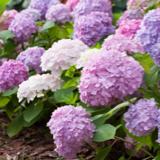
Whether you want to make an indoor garden or you already have one– Check out some of the best & most essential indoor gardening tips for help!
If you recently moved to a big city to get closer to your job or you still want to carry on farming in the dead of winter, do not fret; indoor gardening is a viable option for you. Aside from reaping a bounty harvest of your favorite vegetables, indoor gardening is suitable for growing seedlings for transplanting into a farm or continuing growth after transplanting.
Indoor plants do not require a lot of space and can survive in room corners, window sills or balconies, and they grow in containers in a process called potting. Plants emanate oxygen which in turn cleanses the air in your apartment. People who reside in industrial cities that experience constant smog rely on air conditioning to cleanse the air would appreciate a supply of natural fresh air in their apartments. Indoor plants such as a Bonsai tree provide aesthetic beauty to your home.
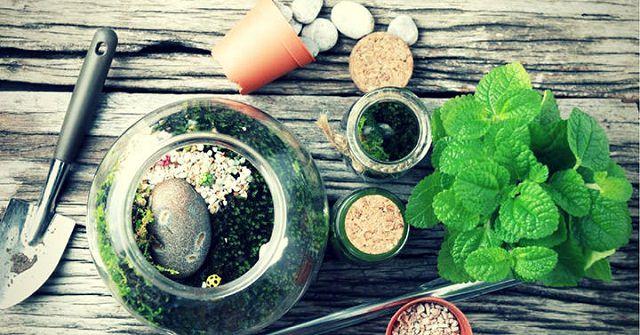
There are different species of Bonsai trees each thriving in various climatic conditions such as junipers, cedars, and pines. Bonsai trees need careful handling while styling the branches and therefore, you need to use an appropriate brush cutter to prune. For best results, seek expert advice on how to take the best care of a bonsai tree.
How do you get started?
There are some factors you need to consider before starting an indoor garden.
1. Available space
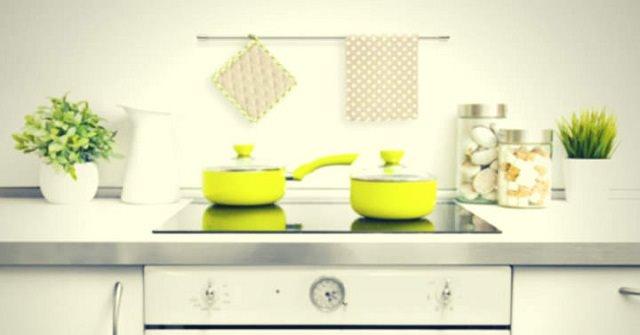
Rent in cities does not come cheap, and most city residents opt for smaller size apartments to keep living costs low. While deciding on a suitable space for indoor plants, consider access to natural light and avoid high traffic areas such as corridors or entryways. You do not want to keep bumping into potted plants or having to go around the garden each time you access the fridge. Find a reasonable place that does not hamper your movement or cause accidents especially if you have younger ones running around.
2. Growing Medium
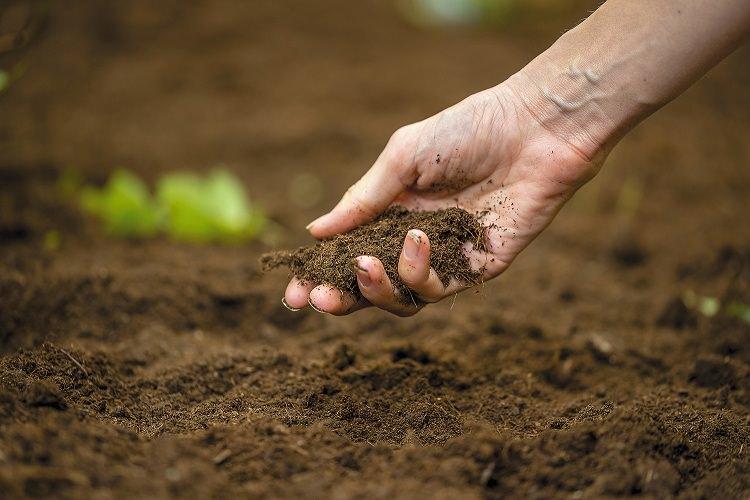
Regular garden soil is not suitable for indoor gardening as it comes with weed and all kinds of insects found on a farm. Farmland holds the plants’ roots together and provides a myriad of nutrients that are necessary for plants to thrive. You can choose to prepare a growing medium or buy a premade one at your local garden store. Potted plants dry out faster than plants growing in the soil and hence the need for a regular watering routine. Overwatering plants leads to wilting in the stems while under watering causes leaves to drop prematurely among other effects.
3. Organic nutrients
Since indoor plants do not grow in soil, you need to provide a natural boost of nutrients by applying organic fertilizer. Read the instructions on the bag to know how much fertilizer to use at a time and the frequency of application. If you are not keen on using fertilizer, you may choose to use Hydroponic nutrients or homemade compost instead.
4. Light
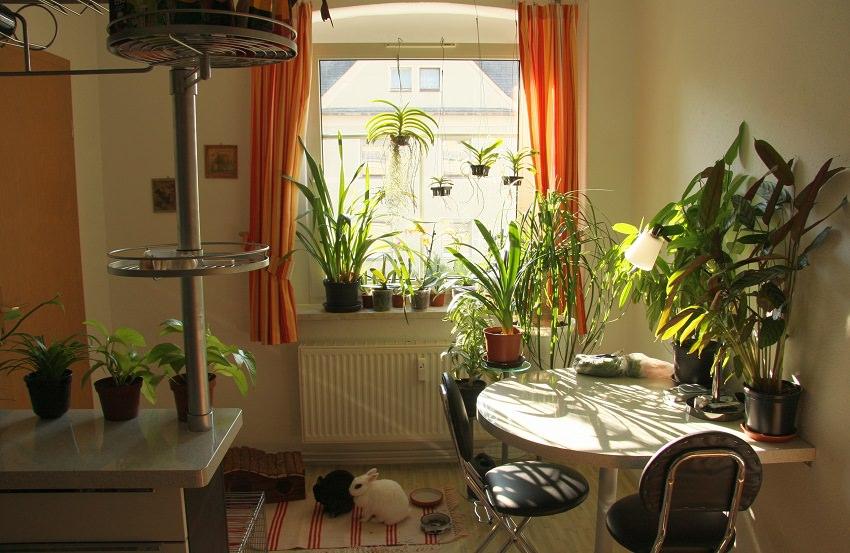
Just as nutrients are essential for the well-being of plants, so is light. Plants need light for photosynthesis which helps plants grow healthy foliage and bear fruits. Tall buildings near your apartment will obscure natural light from reaching your plants even if they are near a window. The winter season tends to be gloomy, and this means limited natural light. A grow light will solve this problem in one click of a switch. Ensure that your grow light has the same wavelength as the sun; it should not be too bright nor too dull.
5. Humidity

Lack of moisture may cause the plants to wither and lose their leaves. There are creative ways of providing enough moisture to indoor plants; try placing the plants together so they can get humidity from one another. Evaporation is an excellent source of moisture for plants. Putting a tray of water next to your plants has a similar humid effect to living near a massive water body like the sea or ocean. You can also place water next to the plants and if this does not work, invest in an environmental controller that shifts the levels of humidity as you wish.
6. Temperature
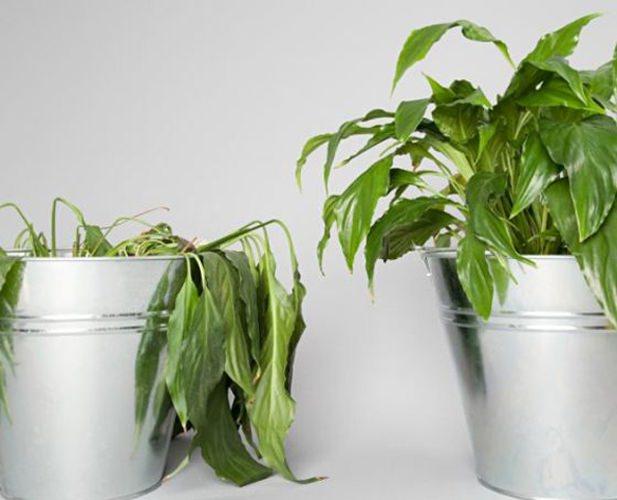
Temperatures vary from day and night and from one season to the next. Plants need correct temperatures to grow and mature. Cold temperatures may cause yellowing of leaves while hot temperatures may lead to stunted growth. Research on the right temperatures for the type of plants you want to grow in your indoor garden and adjust as required.
7. Selecting plants
After considering the fundamental elements of indoor gardening, you can now choose the type of plants you want to grow. Since space is likely to be an issue for apartment dwellers, avoid plants that grow too big as they will eat into your living space. You do not want a jungle in your home! Conventional plants for indoor gardening include flowers, herbs, fruits, bonsai trees, and vegetables.
Conclusion
Lack of land to garden should not thwart you from growing your favorite vegetables or fruit. Indoor gardening is possible in small quarters, and modern technology allows us to simulate environments that match those of a natural garden. This way, your indoor plants can have the same amount of the sunshine, water, and nutrients required to grow to maturity and harvest. Learning how to take the best care of Bonsai trees increases your chances of having these beauties grace your home.
If you recently moved to a big city to get closer to your job or you still want to carry on farming in the dead of winter, do not fret; indoor gardening is a viable option for you. Aside from reaping a bounty harvest of your favorite vegetables, indoor gardening is suitable for growing seedlings for transplanting into a farm or continuing growth after transplanting.
Indoor plants do not require a lot of space and can survive in room corners, window sills or balconies, and they grow in containers in a process called potting. Plants emanate oxygen which in turn cleanses the air in your apartment. People who reside in industrial cities that experience constant smog rely on air conditioning to cleanse the air would appreciate a supply of natural fresh air in their apartments. Indoor plants such as a Bonsai tree provide aesthetic beauty to your home.

There are different species of Bonsai trees each thriving in various climatic conditions such as junipers, cedars, and pines. Bonsai trees need careful handling while styling the branches and therefore, you need to use an appropriate brush cutter to prune. For best results, seek expert advice on how to take the best care of a bonsai tree.
How do you get started?
There are some factors you need to consider before starting an indoor garden.
1. Available space

Rent in cities does not come cheap, and most city residents opt for smaller size apartments to keep living costs low. While deciding on a suitable space for indoor plants, consider access to natural light and avoid high traffic areas such as corridors or entryways. You do not want to keep bumping into potted plants or having to go around the garden each time you access the fridge. Find a reasonable place that does not hamper your movement or cause accidents especially if you have younger ones running around.
2. Growing Medium

Regular garden soil is not suitable for indoor gardening as it comes with weed and all kinds of insects found on a farm. Farmland holds the plants’ roots together and provides a myriad of nutrients that are necessary for plants to thrive. You can choose to prepare a growing medium or buy a premade one at your local garden store. Potted plants dry out faster than plants growing in the soil and hence the need for a regular watering routine. Overwatering plants leads to wilting in the stems while under watering causes leaves to drop prematurely among other effects.
3. Organic nutrients
Since indoor plants do not grow in soil, you need to provide a natural boost of nutrients by applying organic fertilizer. Read the instructions on the bag to know how much fertilizer to use at a time and the frequency of application. If you are not keen on using fertilizer, you may choose to use Hydroponic nutrients or homemade compost instead.
4. Light

Just as nutrients are essential for the well-being of plants, so is light. Plants need light for photosynthesis which helps plants grow healthy foliage and bear fruits. Tall buildings near your apartment will obscure natural light from reaching your plants even if they are near a window. The winter season tends to be gloomy, and this means limited natural light. A grow light will solve this problem in one click of a switch. Ensure that your grow light has the same wavelength as the sun; it should not be too bright nor too dull.
5. Humidity

Lack of moisture may cause the plants to wither and lose their leaves. There are creative ways of providing enough moisture to indoor plants; try placing the plants together so they can get humidity from one another. Evaporation is an excellent source of moisture for plants. Putting a tray of water next to your plants has a similar humid effect to living near a massive water body like the sea or ocean. You can also place water next to the plants and if this does not work, invest in an environmental controller that shifts the levels of humidity as you wish.
6. Temperature

Temperatures vary from day and night and from one season to the next. Plants need correct temperatures to grow and mature. Cold temperatures may cause yellowing of leaves while hot temperatures may lead to stunted growth. Research on the right temperatures for the type of plants you want to grow in your indoor garden and adjust as required.
7. Selecting plants
After considering the fundamental elements of indoor gardening, you can now choose the type of plants you want to grow. Since space is likely to be an issue for apartment dwellers, avoid plants that grow too big as they will eat into your living space. You do not want a jungle in your home! Conventional plants for indoor gardening include flowers, herbs, fruits, bonsai trees, and vegetables.
Conclusion
Lack of land to garden should not thwart you from growing your favorite vegetables or fruit. Indoor gardening is possible in small quarters, and modern technology allows us to simulate environments that match those of a natural garden. This way, your indoor plants can have the same amount of the sunshine, water, and nutrients required to grow to maturity and harvest. Learning how to take the best care of Bonsai trees increases your chances of having these beauties grace your home.
2
2
文章
扭扭
2017年05月23日

Indoor gardening can be a challenge if you’re short of space. And, for your help here’re the 15 Brilliant Vertical Indoor Garden Ideas, by applying a few of these you’ll be able to create more space!1. Vertical Pallet Planter
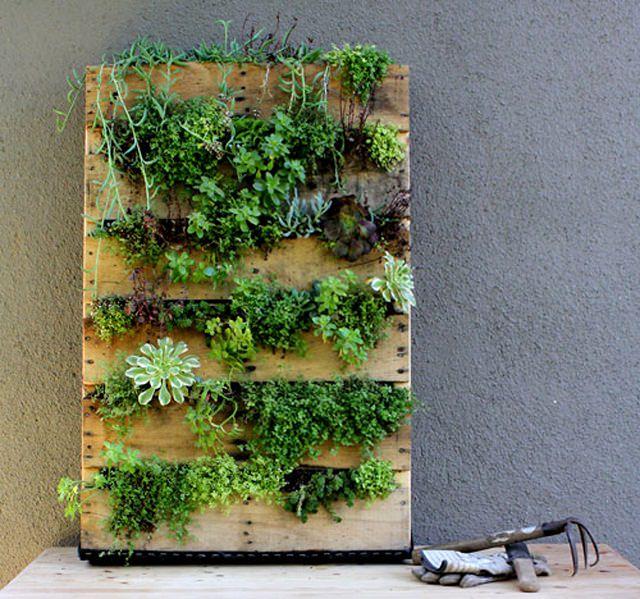
Make a vertical pallet planter to create an adorable indoor garden easily and inexpensively. They’ll provide enough space for growing herbs and succulents without taking a much of floor space. Check out how to make one.
2. Dresser Planter

A bit quirky idea! Use an old dresser to create a stunning indoor garden. Plant some ferns and succulents in its drawers and also place some on top to create a beautiful indoor garden.
3. Indoor Ladder Planter

Previously we wrote a lot about the use of ladder planter in a balcony or rooftop garden. A practical idea! You can apply it to your indoor garden too! An old ladder is perfect to grow multiple house plants in limited space. To make this, simply add several wood planks on ladder steps to create shelves. Then plants your houseplants on it but be sure to place houseplants that have similar light requirements. Here is more on it.
4. DIY Pot Hanger
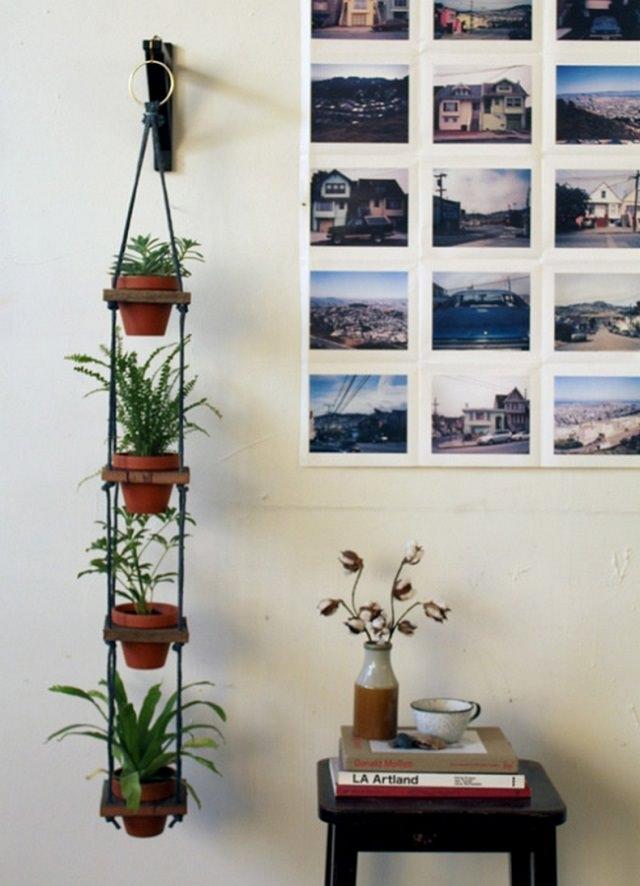
A unique (or say bizarre) way to display your favorite houseplants. This easy project only requires some scrap wood, rope, and a few basic woodworking tools. The best part is that the system makes watering a breeze. All the runoff from the previous pot drips into the plants below, so you only need to water the plant on top and be sure place a saucer under the bottom most pot. Here is the tutorial.
5. TV Stand Vertical Garden
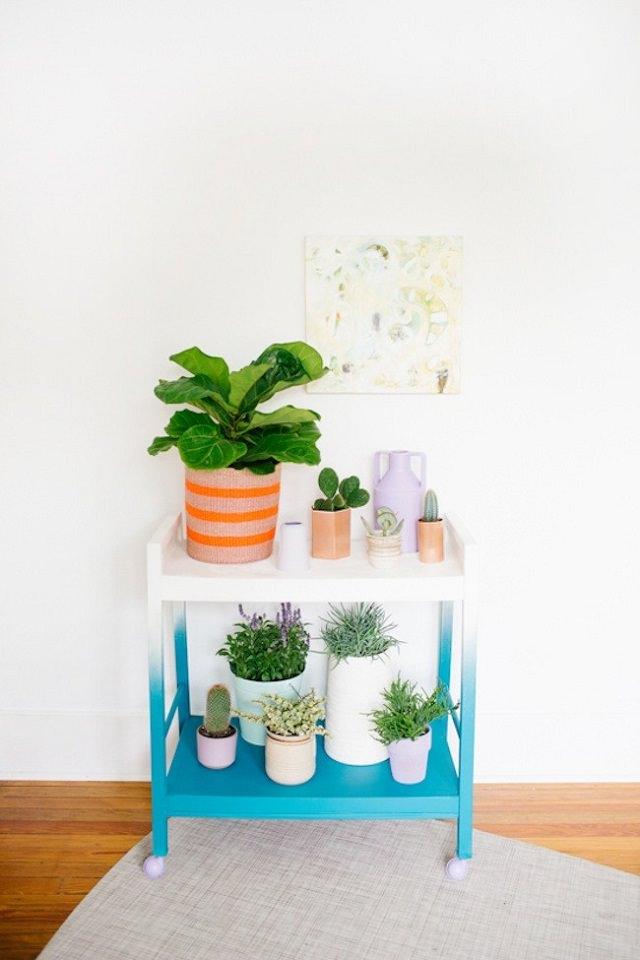
Got an old TV Stand? Make a vertical indoor garden out of it. This is a great way to recycle your old TV stand and transform it to a living beauty. You can either paint it for a fresh new look or use it as it is for a rustic look.
6. Hanging Plastic Bottle Cactus Garden
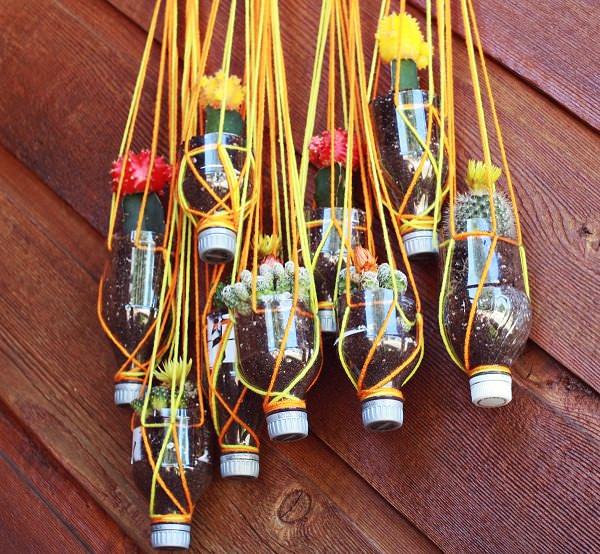
Do you want to create a vertical soda bottle garden? Follow this idea. All that is required is bottles cut in half, cactus plants or succulents, and many colorful threads to get a really cool decorative look. Here you can see the complete tutorial.
7. Shoe Organizer Vertical Garden
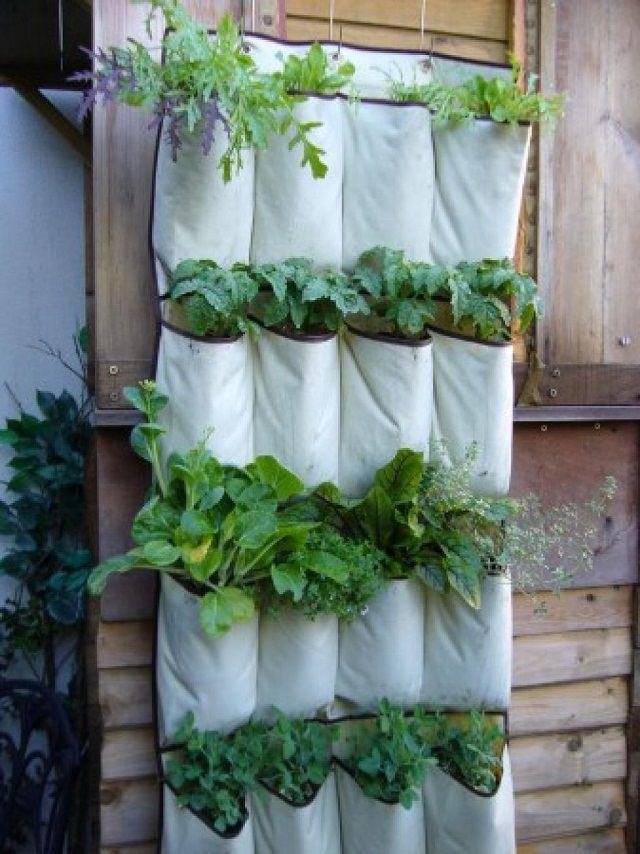
A hanging shoe organizer is perfect for your vertical INDOOR garden. Its pockets are the ideal size for growing individual plants and herbs. Get the DIY instructions here.
8. Vertical Herb Garden

Want to grow herbs but you don’t have space (short of budget too)? Well, even a wooden plank is enough. All you need is some plastic bottles, hooks, nails and hammer and you’re all set to grow your own herbs.
9. Mason Jar Vertical Garden

Don’t throw away those old mason jars, use them creatively to make an indoor herb wall garden. Metal bands and screws hold the jars in place against a scrap piece of wood that is mounted on the wall. Fill in the soil and plant your favorite herbs to use them all year round. Read about more Mason Jar Uses here!
10. Hanging Coconut Planter

Use coconut shells after eating to create this super cute hanging indoor garden. This project is unique, still simple and doesn’t require much. Check out the tutorial here.
11. Pallet Container Holder

Arrange a pallet board and hang several pots on it. It’s easy! And the best part is it will create plenty of vertical space.
12. Vertical Picture Frame Planter
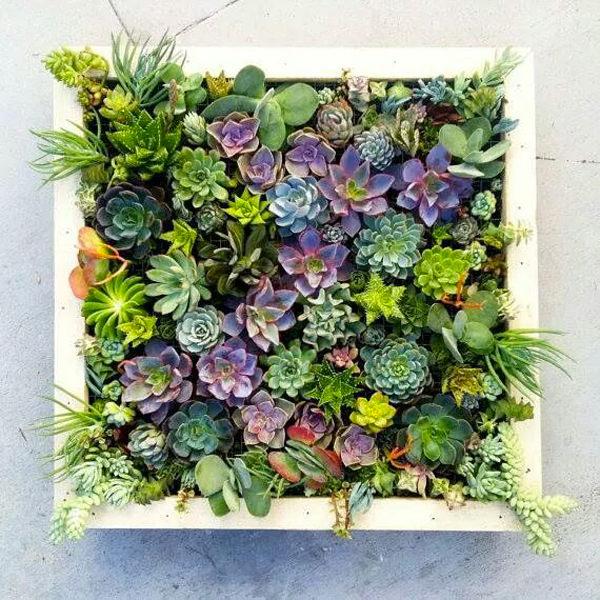
A cool idea for your room if it receives some sun to make it greener, you can hang a wall planter like this in your room. See the step by step tutorial on our website.
13. Vertical Pot Holder From Pallet Planks

Dismantle a pallet board and separate the pallet planks; nail them on to the wall and fix the pots. Simple!
14. Hanging Terracotta Planters

Vertical gardening is a boon for those who’re short of space. A tutorial is available here.
15. Iron Grid Pot Holder
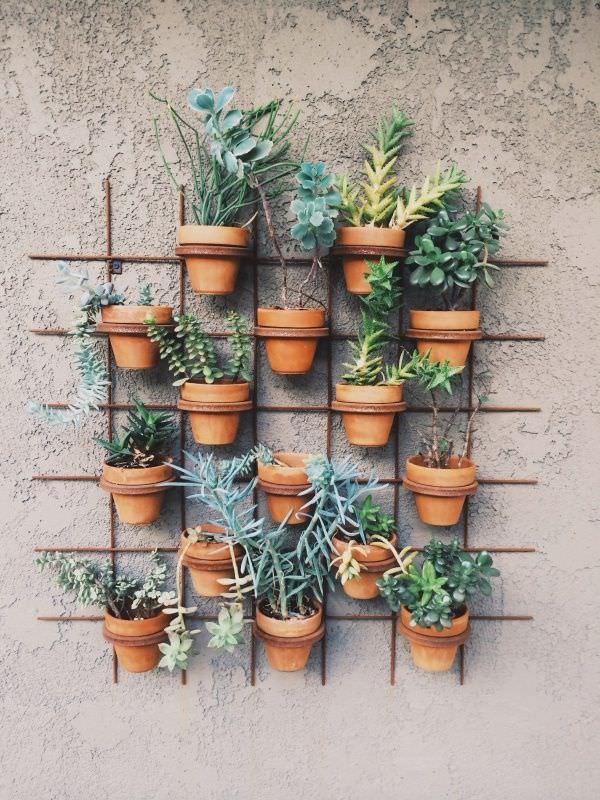
You can make a grid like this by welding the iron rods or weave them by any other method so that you’ll be able to hang the pots. You can paint that too in your favorite color. *The grid can also be made of wood.

Make a vertical pallet planter to create an adorable indoor garden easily and inexpensively. They’ll provide enough space for growing herbs and succulents without taking a much of floor space. Check out how to make one.
2. Dresser Planter

A bit quirky idea! Use an old dresser to create a stunning indoor garden. Plant some ferns and succulents in its drawers and also place some on top to create a beautiful indoor garden.
3. Indoor Ladder Planter

Previously we wrote a lot about the use of ladder planter in a balcony or rooftop garden. A practical idea! You can apply it to your indoor garden too! An old ladder is perfect to grow multiple house plants in limited space. To make this, simply add several wood planks on ladder steps to create shelves. Then plants your houseplants on it but be sure to place houseplants that have similar light requirements. Here is more on it.
4. DIY Pot Hanger

A unique (or say bizarre) way to display your favorite houseplants. This easy project only requires some scrap wood, rope, and a few basic woodworking tools. The best part is that the system makes watering a breeze. All the runoff from the previous pot drips into the plants below, so you only need to water the plant on top and be sure place a saucer under the bottom most pot. Here is the tutorial.
5. TV Stand Vertical Garden

Got an old TV Stand? Make a vertical indoor garden out of it. This is a great way to recycle your old TV stand and transform it to a living beauty. You can either paint it for a fresh new look or use it as it is for a rustic look.
6. Hanging Plastic Bottle Cactus Garden

Do you want to create a vertical soda bottle garden? Follow this idea. All that is required is bottles cut in half, cactus plants or succulents, and many colorful threads to get a really cool decorative look. Here you can see the complete tutorial.
7. Shoe Organizer Vertical Garden

A hanging shoe organizer is perfect for your vertical INDOOR garden. Its pockets are the ideal size for growing individual plants and herbs. Get the DIY instructions here.
8. Vertical Herb Garden

Want to grow herbs but you don’t have space (short of budget too)? Well, even a wooden plank is enough. All you need is some plastic bottles, hooks, nails and hammer and you’re all set to grow your own herbs.
9. Mason Jar Vertical Garden

Don’t throw away those old mason jars, use them creatively to make an indoor herb wall garden. Metal bands and screws hold the jars in place against a scrap piece of wood that is mounted on the wall. Fill in the soil and plant your favorite herbs to use them all year round. Read about more Mason Jar Uses here!
10. Hanging Coconut Planter

Use coconut shells after eating to create this super cute hanging indoor garden. This project is unique, still simple and doesn’t require much. Check out the tutorial here.
11. Pallet Container Holder

Arrange a pallet board and hang several pots on it. It’s easy! And the best part is it will create plenty of vertical space.
12. Vertical Picture Frame Planter

A cool idea for your room if it receives some sun to make it greener, you can hang a wall planter like this in your room. See the step by step tutorial on our website.
13. Vertical Pot Holder From Pallet Planks

Dismantle a pallet board and separate the pallet planks; nail them on to the wall and fix the pots. Simple!
14. Hanging Terracotta Planters

Vertical gardening is a boon for those who’re short of space. A tutorial is available here.
15. Iron Grid Pot Holder

You can make a grid like this by welding the iron rods or weave them by any other method so that you’ll be able to hang the pots. You can paint that too in your favorite color. *The grid can also be made of wood.
1
0
文章
lenny
2017年05月23日
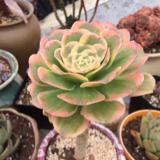
Whether you have a rooftop garden already or you are planning to have one, these 11 rooftop garden design ideas and tips will help you in having the most beautiful roof terrace garden.
In densely populated urban areas of the cities even having a small rooftop or patio is such a boon. You can create a garden there. You can sit there and enjoy.
Surely you may have many plans about your rooftop garden design and style but considering these tips will be helpful too.
Rooftop Garden Design Ideas and Tips
We have some great terrace garden design ideas and essential tips that you can use for inspiration on your rooftop.
1. Keep it open

A small rooftop if kept open looks big. Consider, for example, transparent glass instead of a parapet wall; fences, railing or even you can create a hedge around the border. However, if you are concerned about the privacy and would like to block the constantly prying eyes of the neighbors, avoid this tip.
2. Grow tall plants and trees

If you have a large rooftop or have a bad view from there or if you want to get a real garden like feel do little high vegetation around the walls to maximize greenery and confine yourself from the rest of the city. Growing bamboos and grasses is a good combination if you want to make it low maintenance, otherwise, your options are unlimited, grow shrubs and trees.
3. Create raised beds
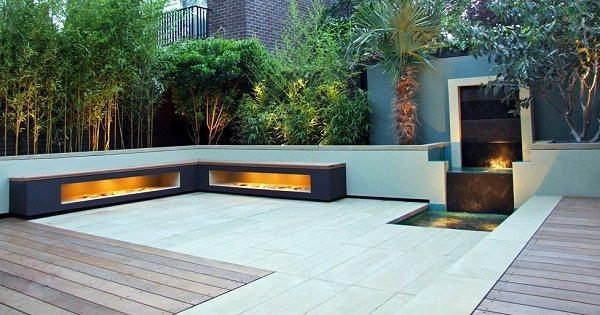
If your roof supports, creating raised beds adjacent to the walls is a good idea. You can add wooden raised beds or the ones that are made from metal. If you like, you can also construct the concrete raised beds– 2 feet deep and wide would be a great size, in them you can even grow tall shrubs and small trees and with the regular maintenance, pruning, and root trimming in every few years you can control the plants.
For these raised beds ensure you use waterproofing membrane and lay a thick root barrier that can block roots and prevent damage to the roof. One more idea is to make slightly elevated raised beds from the surface that way the raised beds do not touch the surface and roots of the plants may not be able to penetrate.
4. Plant carefully
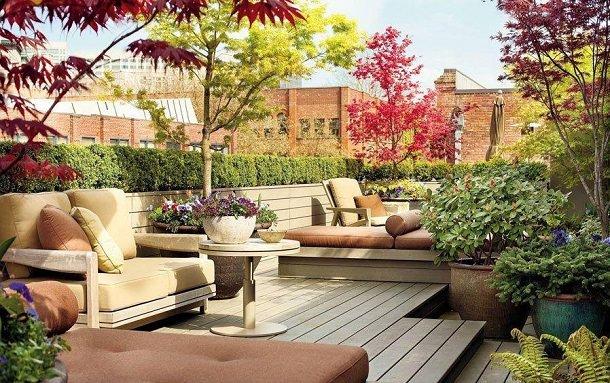
When it comes to rooftop garden design, ensure you maintain the diversity in the size of the plants. A few large plants, shrubs and small trees, ground covers, annuals must be there. Also, buy containers of different sizes this will give a great look to your rooftop garden.
5. Furniture


Decide in advance what kind of furniture you would like to purchase. Would you like to lounge on the roof terrace or want to have a dinner there? You must make a choice in the initial stage. Furniture that fit the style and theme of your garden would be appropriate.
6. Add a focal point

A focal point attracts the eyes toward it. Anything can be a focal point that draws attention. A water feature, tall tree, beautiful arrangement of container plants, a statue etc.
7. Do lighting

During the evening, it is important that your rooftop garden is well-lit. Especially near the stairwell or door, it’s nice to make more bright spots. Moreover, lighting a roof will make it look larger during dusk.
8. Use no more than three colors
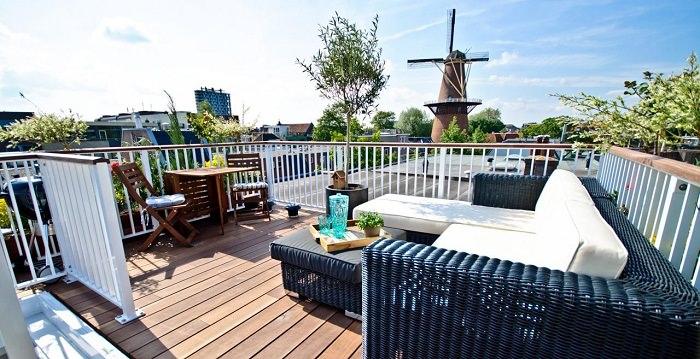
Always choose one color as an accent color and one or two more colors that’ll follow it. Using several different colors for walls, floor, railings, furniture or containers will make your rooftop look too busy and cluttered. A color combined with a neutral color works best. Neutral colors like white, gray, beige, indigo also accentuate the beauty of plants.
9. Utilize vertical space

Utilize vertical space to add more space to your rooftop garden, hang planters on the walls, use railing planters and grow a lot of climbers.
10. Nice floor is important

Don’t avoid the flooring. Choose flooring type that fits your budget, suits the climate you live in and accommodate the theme of the rooftop garden.
11. Play with colors and plant types

Use cool colors and warm colors in balance to get a beautiful look. On a well planned urban rooftop garden, everything is possible. Grow trees, shrubs, foliage plant and annuals for a burst of color.
In densely populated urban areas of the cities even having a small rooftop or patio is such a boon. You can create a garden there. You can sit there and enjoy.
Surely you may have many plans about your rooftop garden design and style but considering these tips will be helpful too.
Rooftop Garden Design Ideas and Tips
We have some great terrace garden design ideas and essential tips that you can use for inspiration on your rooftop.
1. Keep it open

A small rooftop if kept open looks big. Consider, for example, transparent glass instead of a parapet wall; fences, railing or even you can create a hedge around the border. However, if you are concerned about the privacy and would like to block the constantly prying eyes of the neighbors, avoid this tip.
2. Grow tall plants and trees

If you have a large rooftop or have a bad view from there or if you want to get a real garden like feel do little high vegetation around the walls to maximize greenery and confine yourself from the rest of the city. Growing bamboos and grasses is a good combination if you want to make it low maintenance, otherwise, your options are unlimited, grow shrubs and trees.
3. Create raised beds

If your roof supports, creating raised beds adjacent to the walls is a good idea. You can add wooden raised beds or the ones that are made from metal. If you like, you can also construct the concrete raised beds– 2 feet deep and wide would be a great size, in them you can even grow tall shrubs and small trees and with the regular maintenance, pruning, and root trimming in every few years you can control the plants.
For these raised beds ensure you use waterproofing membrane and lay a thick root barrier that can block roots and prevent damage to the roof. One more idea is to make slightly elevated raised beds from the surface that way the raised beds do not touch the surface and roots of the plants may not be able to penetrate.
4. Plant carefully

When it comes to rooftop garden design, ensure you maintain the diversity in the size of the plants. A few large plants, shrubs and small trees, ground covers, annuals must be there. Also, buy containers of different sizes this will give a great look to your rooftop garden.
5. Furniture


Decide in advance what kind of furniture you would like to purchase. Would you like to lounge on the roof terrace or want to have a dinner there? You must make a choice in the initial stage. Furniture that fit the style and theme of your garden would be appropriate.
6. Add a focal point

A focal point attracts the eyes toward it. Anything can be a focal point that draws attention. A water feature, tall tree, beautiful arrangement of container plants, a statue etc.
7. Do lighting

During the evening, it is important that your rooftop garden is well-lit. Especially near the stairwell or door, it’s nice to make more bright spots. Moreover, lighting a roof will make it look larger during dusk.
8. Use no more than three colors

Always choose one color as an accent color and one or two more colors that’ll follow it. Using several different colors for walls, floor, railings, furniture or containers will make your rooftop look too busy and cluttered. A color combined with a neutral color works best. Neutral colors like white, gray, beige, indigo also accentuate the beauty of plants.
9. Utilize vertical space

Utilize vertical space to add more space to your rooftop garden, hang planters on the walls, use railing planters and grow a lot of climbers.
10. Nice floor is important

Don’t avoid the flooring. Choose flooring type that fits your budget, suits the climate you live in and accommodate the theme of the rooftop garden.
11. Play with colors and plant types

Use cool colors and warm colors in balance to get a beautiful look. On a well planned urban rooftop garden, everything is possible. Grow trees, shrubs, foliage plant and annuals for a burst of color.
0
1
文章
Colorful
2017年05月23日

Plants grown indoors bring nature into the home but do you know there are plants that can help you sleep better? 14 Best Houseplants for a Restful Sleep. Take a look!
Plants are known to improve the overall appearance of your home, but do you know they also contributes to your overall health? There are plants that are actually known to have soothing properties and help if you have trouble sleeping from time to time, you can benefit from such plants– not only they detoxify your bedroom’s air, but help you get a warm good night sleep as well.
To start, here are 14 of the best plants you can grow. They add warmth, relaxing fragrance and effectively increase oxygen levels in your room, thus giving you a restful sleep. Try adding one of them in your bedroom to get a little dose of zen.1. Jasmine

The jasmine plant features lovely little white flowers and a warm intense scent known to induce relaxing qualities ever since the ancient times. Studies have found that Jasmine has sedative properties and can significantly reduce anxiety levels, thus giving a positive impact on sleep quality.
How to grow: Use soilless potting mix and plant your jasmine in a medium to large size pot. It’s best to place it in a warm spot with full sun exposure (at least 4-5 hours a day).
2. Gardenia
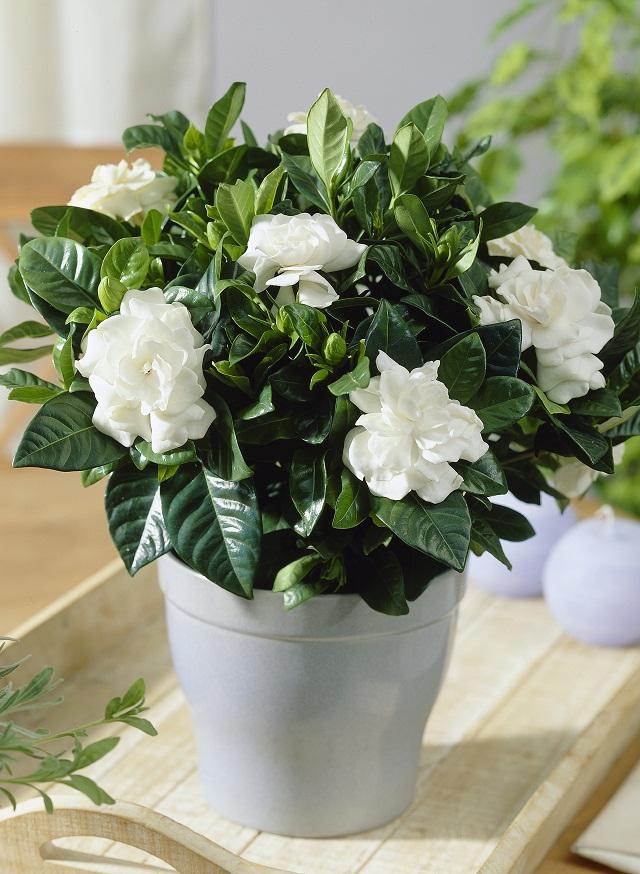
Like the jasmine, gardenia features big white flowers and an intoxicating fragrance that is incomparable– not to mention it also comes with a sedative effect. A study conducted in 2010 has shown that the sweet smell of gardenia flowers has the same effectiveness as that of valium in relaxing the body and brain. So instead of relying on sleeping pills, keeping a gardenia in your bedroom or outside your bedroom window could help you sleep more effectively.
Also Read: Most Fragrant Flowers
How to grow: Gardenia is a fussy plant and requires some care, you can read this growing guide in detail to learn how to grow gardenia in a container.
3. Bamboo Palm

The bamboo palm is great for removing trichloroethylene and benzene, two chemicals which are known to induce respiratory problems, thus a great AIR PURIFYING PLANT. With the plant’s excellent filtering property, you can expect a restful sleep when keeping it in your bedroom. It has been awarded a high purifying score of 8.4 in a study conducted by NASA.
How to grow: Bamboo palm grows perfectly well in shade or in indirect sunlight. It needs a slightly moist soil to thrive but at any case overwatering must be avoided.
Also Read: Best Tall Indoor Plants
4. Valerian
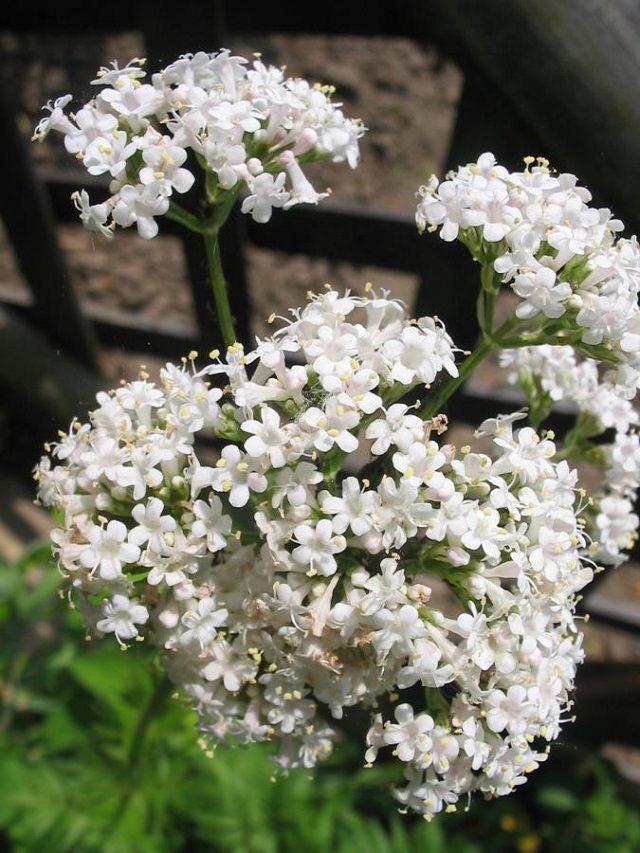
The valerian is a perennial flowering herb which features white, red or pink flowers during summer. It is popular among herbalists in treating anxiety, insomnia, and over-excitability, with its roots being commonly used as an ingredient in mild sedatives. When flowering, the valerian produces a calming vanilla fragrance which induces sleep.
How to grow: The plant will need a minimum sunlight exposure of six hours a day. It’s a good choice if your bedroom has a bright window ledge. It will require rich soil and a lot of water.
Also Read: How to Grow Valerian
5. Honeysuckle
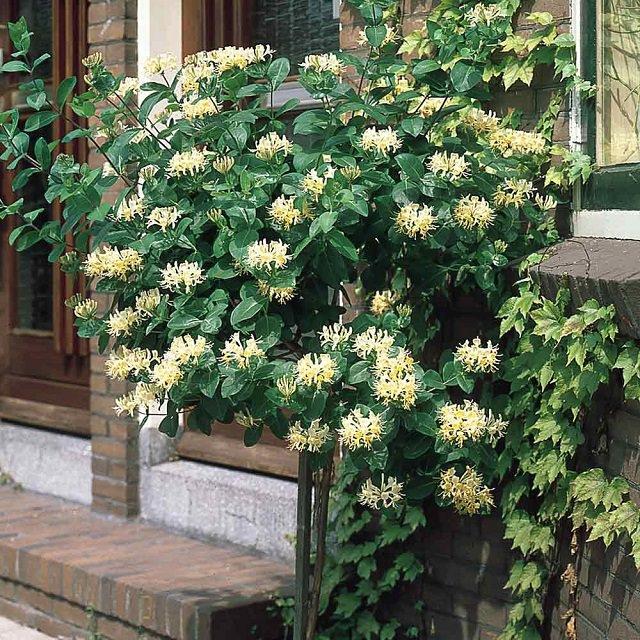
The warm mild fragrance of honeysuckle flowers gets more intense in the dark of the dusk. No wonder, it has the most intoxicating aroma. Growing honeysuckle indoors isn’t practical you may think as it’s a big vine. It is! But you can grow dwarf bush honeysuckle, it’s unique and grow only 4 feet tall. Plant it near a window where it will receive partial sun, it can tolerate shade too.
If you have space try growing a honeysuckle vine outside your bedroom window. Either in a large pot or on the ground.
How to grow: You can grow dwarf honeysuckle indoors near a south or west facing window that receives at least 5-6 hours of sun. Also, the honeysuckle prefers slightly moist soil so keep care of it.
Also Read: Best Vines for Containers
6. Rubber Tree Plant

Besides the ornamental aspect, rubber tree is considered as an air purifying plant. It’s proved that growing rubber tree indoors is beneficial as it cleanses the formaldehyde.
How to Grow: Avoid direct sunlight, especially afternoon sun. Otherwise, the leaves will eventually fall off. Place the plant on a bright and well-lit spot that receives indirect or morning sunlight. To read more on how to grow a rubber tree plant, click here!
7. Peace Lily

The peace lily plant has an ability to filter harmful toxins from the air. Apart from it looking exceptional, it also helps in getting rid of any impurities and airborne microbes that could disturb your sleep.
How to grow: Peace lilies are low maintenance plants, only requiring watering on a weekly basis, usually when top 2 inches soil seems dry. They often grow best in a shady spot.
8. Aloe Vera
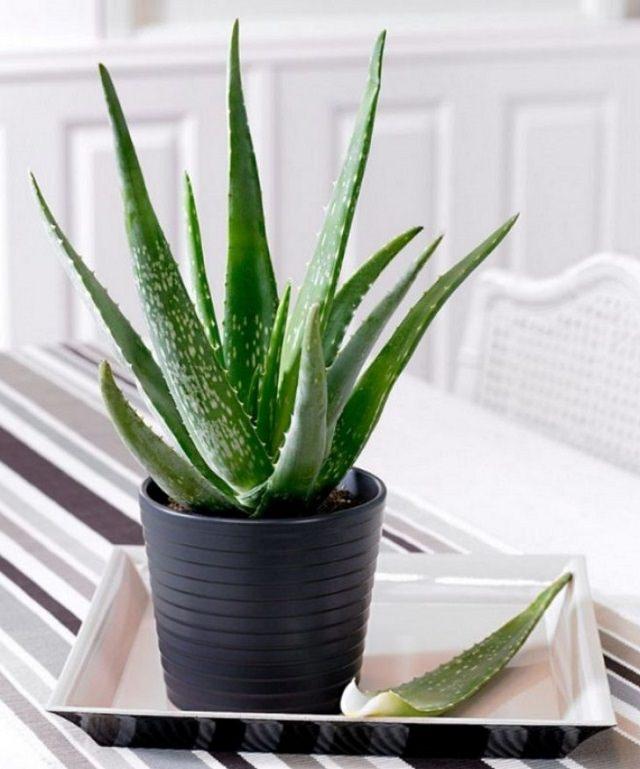
Aloe vera is widely known for its healing property, but it is also considered the most effective plant in terms of filtering out hazardous chemicals and toxins in the air. It lets out oxygen during nighttime, something which is not typical for plants, hence leaving you with a fresher and cleaner air for a more restful sleep. It also produces volatile which provides a positive effect on your immune system. By having an aloe vera inside your bedroom, you can expect a good night sleep.
How to grow: Aloe vera is very easy to care for since it doesn’t require frequent watering. It grows best on spots that receive some sun.
9. Spider Plant
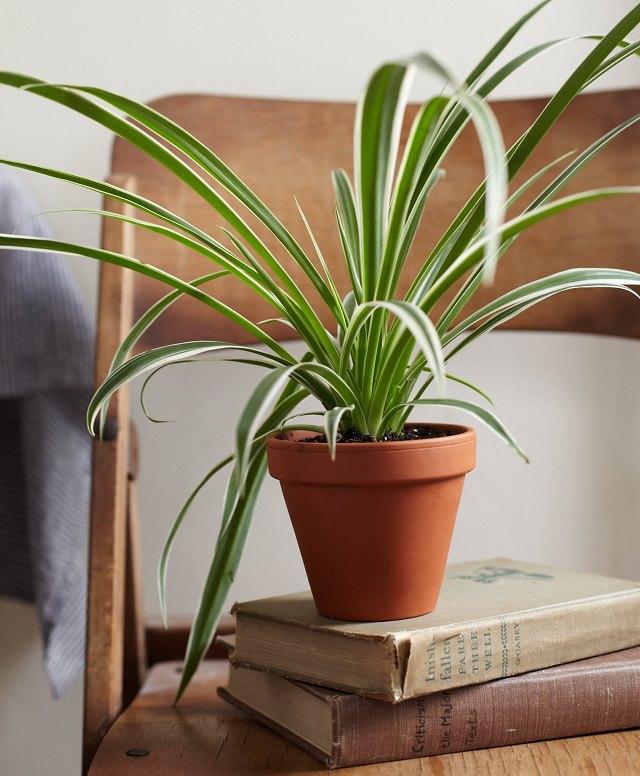
Spider plants are one of the most common house plants which made it to NASA’s list of the most excellent air filtering plants. Spider plants are capable of removing up to 90% of harmful formaldehyde in the air that surrounds them. Other than formaldehyde, they are also capable of filtering benzene, xylene, and carbon monoxide.
How to grow: Spider plants are very easy to grow. As long as they’re provided with a well-drained soil, enough water, and a bright light, they will thrive well.
Also Read: Easiest Houseplant
10. English Ivy plant
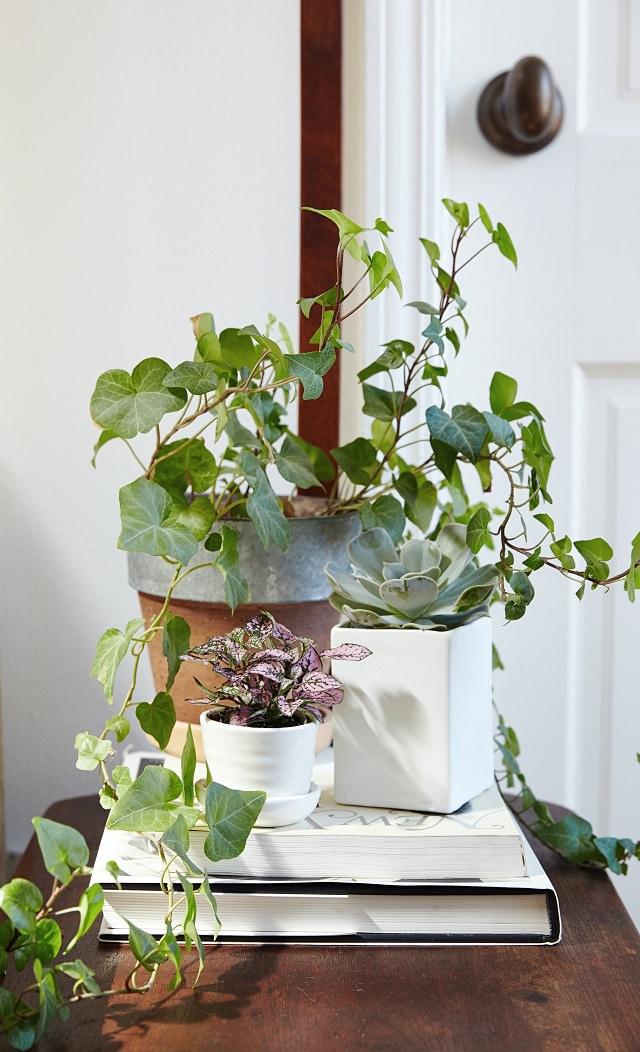
The English ivy plant is a leader when it comes to purifying air, it is also a very hardy plant and thrive in shade. All this makes it an excellent choice for bedrooms. Also, it is discovered to help those who suffer from allergy by purifying the air in its surroundings. With the air effectively purified, you are guaranteed to have a more restful sleep.
How to grow: An English ivy plant is toxic if ingested, which is why you should choose another plant to place in your bedroom if there are small children or pets with you. They grow well in moderate temperatures with moderate sunlight.
11. Lavender

The scent of lavender induces calmness. A study conducted in 2008 has found that the plant’s scent help soothe fussy babies and help them fall into a deep sleep stage. Other than that, research has shown that the lavender is effective for lowering heart rate and blood pressure. As an alternative for the plant, you can use lavender essential oil to get a better sleep.
How to grow: The plant grows best when placed in a bright window with full exposure to the sun. It only requires moderate watering. To learn more click here!
12. Snake plant

According to NASA, the snake plant is among the 10 best houseplants that help filter the air. It absorbs carbon dioxide while at the same time releases oxygen during nighttime, hence allowing you to achieve deep sleep. Through this process, you can expect a naturally clean and fresh air inside your bedroom.
How to grow: A snake plant is a succulent and doesn’t need that much of water or light, hence you can simply place it even in the darkest of corners of your room. It’s actually a low maintenance plant that is ideal for beginners.
Also Read: Plants that Grow without Sunlight
13. Pothos

All plants belong to the pothos family are very easy to grow and low maintenance. This beautiful can be grown in dim corners.
How to Grow: This attractive and hardy vine prefers bright indirect light and a draft free place. It can even grow in really low light and needs slightly moist soil.
14. Hoya
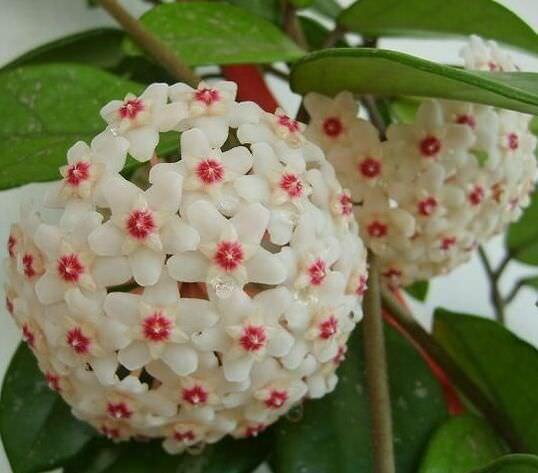
Thick green leathery leaves and long slender stems– the hoya (wax plant) looks beautiful even without its cluster of uniform star-shaped flowers. Sweetly scented hoya flowers can be a wonderful addition to your bedroom and help in providing a RESTFUL SLEEP.
How to grow: Keep the plant in a spot that receives bright indirect sun all day long, a couple of hours of morning sun would be better. Must remember hoya plant requires moderate watering and warm room temperature.
Tips to consider when introducing plants in your room
If you plan on putting houseplants inside your house, make sure you consider the following tips:
Check if they are toxic to the kids and pets inside of your house.Wipe the leaves once a week to make sure the plants can perform their best.Mix your plants with the ones that purify air and the ones that induce deep sleep through their scents.NASA recommends keeping between 15 to 18 air purifying plants in an 1800 sq. ft house, with only a few of them in each bedroom.
Plants are known to improve the overall appearance of your home, but do you know they also contributes to your overall health? There are plants that are actually known to have soothing properties and help if you have trouble sleeping from time to time, you can benefit from such plants– not only they detoxify your bedroom’s air, but help you get a warm good night sleep as well.
To start, here are 14 of the best plants you can grow. They add warmth, relaxing fragrance and effectively increase oxygen levels in your room, thus giving you a restful sleep. Try adding one of them in your bedroom to get a little dose of zen.1. Jasmine

The jasmine plant features lovely little white flowers and a warm intense scent known to induce relaxing qualities ever since the ancient times. Studies have found that Jasmine has sedative properties and can significantly reduce anxiety levels, thus giving a positive impact on sleep quality.
How to grow: Use soilless potting mix and plant your jasmine in a medium to large size pot. It’s best to place it in a warm spot with full sun exposure (at least 4-5 hours a day).
2. Gardenia

Like the jasmine, gardenia features big white flowers and an intoxicating fragrance that is incomparable– not to mention it also comes with a sedative effect. A study conducted in 2010 has shown that the sweet smell of gardenia flowers has the same effectiveness as that of valium in relaxing the body and brain. So instead of relying on sleeping pills, keeping a gardenia in your bedroom or outside your bedroom window could help you sleep more effectively.
Also Read: Most Fragrant Flowers
How to grow: Gardenia is a fussy plant and requires some care, you can read this growing guide in detail to learn how to grow gardenia in a container.
3. Bamboo Palm

The bamboo palm is great for removing trichloroethylene and benzene, two chemicals which are known to induce respiratory problems, thus a great AIR PURIFYING PLANT. With the plant’s excellent filtering property, you can expect a restful sleep when keeping it in your bedroom. It has been awarded a high purifying score of 8.4 in a study conducted by NASA.
How to grow: Bamboo palm grows perfectly well in shade or in indirect sunlight. It needs a slightly moist soil to thrive but at any case overwatering must be avoided.
Also Read: Best Tall Indoor Plants
4. Valerian

The valerian is a perennial flowering herb which features white, red or pink flowers during summer. It is popular among herbalists in treating anxiety, insomnia, and over-excitability, with its roots being commonly used as an ingredient in mild sedatives. When flowering, the valerian produces a calming vanilla fragrance which induces sleep.
How to grow: The plant will need a minimum sunlight exposure of six hours a day. It’s a good choice if your bedroom has a bright window ledge. It will require rich soil and a lot of water.
Also Read: How to Grow Valerian
5. Honeysuckle

The warm mild fragrance of honeysuckle flowers gets more intense in the dark of the dusk. No wonder, it has the most intoxicating aroma. Growing honeysuckle indoors isn’t practical you may think as it’s a big vine. It is! But you can grow dwarf bush honeysuckle, it’s unique and grow only 4 feet tall. Plant it near a window where it will receive partial sun, it can tolerate shade too.
If you have space try growing a honeysuckle vine outside your bedroom window. Either in a large pot or on the ground.
How to grow: You can grow dwarf honeysuckle indoors near a south or west facing window that receives at least 5-6 hours of sun. Also, the honeysuckle prefers slightly moist soil so keep care of it.
Also Read: Best Vines for Containers
6. Rubber Tree Plant

Besides the ornamental aspect, rubber tree is considered as an air purifying plant. It’s proved that growing rubber tree indoors is beneficial as it cleanses the formaldehyde.
How to Grow: Avoid direct sunlight, especially afternoon sun. Otherwise, the leaves will eventually fall off. Place the plant on a bright and well-lit spot that receives indirect or morning sunlight. To read more on how to grow a rubber tree plant, click here!
7. Peace Lily

The peace lily plant has an ability to filter harmful toxins from the air. Apart from it looking exceptional, it also helps in getting rid of any impurities and airborne microbes that could disturb your sleep.
How to grow: Peace lilies are low maintenance plants, only requiring watering on a weekly basis, usually when top 2 inches soil seems dry. They often grow best in a shady spot.
8. Aloe Vera

Aloe vera is widely known for its healing property, but it is also considered the most effective plant in terms of filtering out hazardous chemicals and toxins in the air. It lets out oxygen during nighttime, something which is not typical for plants, hence leaving you with a fresher and cleaner air for a more restful sleep. It also produces volatile which provides a positive effect on your immune system. By having an aloe vera inside your bedroom, you can expect a good night sleep.
How to grow: Aloe vera is very easy to care for since it doesn’t require frequent watering. It grows best on spots that receive some sun.
9. Spider Plant

Spider plants are one of the most common house plants which made it to NASA’s list of the most excellent air filtering plants. Spider plants are capable of removing up to 90% of harmful formaldehyde in the air that surrounds them. Other than formaldehyde, they are also capable of filtering benzene, xylene, and carbon monoxide.
How to grow: Spider plants are very easy to grow. As long as they’re provided with a well-drained soil, enough water, and a bright light, they will thrive well.
Also Read: Easiest Houseplant
10. English Ivy plant

The English ivy plant is a leader when it comes to purifying air, it is also a very hardy plant and thrive in shade. All this makes it an excellent choice for bedrooms. Also, it is discovered to help those who suffer from allergy by purifying the air in its surroundings. With the air effectively purified, you are guaranteed to have a more restful sleep.
How to grow: An English ivy plant is toxic if ingested, which is why you should choose another plant to place in your bedroom if there are small children or pets with you. They grow well in moderate temperatures with moderate sunlight.
11. Lavender

The scent of lavender induces calmness. A study conducted in 2008 has found that the plant’s scent help soothe fussy babies and help them fall into a deep sleep stage. Other than that, research has shown that the lavender is effective for lowering heart rate and blood pressure. As an alternative for the plant, you can use lavender essential oil to get a better sleep.
How to grow: The plant grows best when placed in a bright window with full exposure to the sun. It only requires moderate watering. To learn more click here!
12. Snake plant

According to NASA, the snake plant is among the 10 best houseplants that help filter the air. It absorbs carbon dioxide while at the same time releases oxygen during nighttime, hence allowing you to achieve deep sleep. Through this process, you can expect a naturally clean and fresh air inside your bedroom.
How to grow: A snake plant is a succulent and doesn’t need that much of water or light, hence you can simply place it even in the darkest of corners of your room. It’s actually a low maintenance plant that is ideal for beginners.
Also Read: Plants that Grow without Sunlight
13. Pothos

All plants belong to the pothos family are very easy to grow and low maintenance. This beautiful can be grown in dim corners.
How to Grow: This attractive and hardy vine prefers bright indirect light and a draft free place. It can even grow in really low light and needs slightly moist soil.
14. Hoya

Thick green leathery leaves and long slender stems– the hoya (wax plant) looks beautiful even without its cluster of uniform star-shaped flowers. Sweetly scented hoya flowers can be a wonderful addition to your bedroom and help in providing a RESTFUL SLEEP.
How to grow: Keep the plant in a spot that receives bright indirect sun all day long, a couple of hours of morning sun would be better. Must remember hoya plant requires moderate watering and warm room temperature.
Tips to consider when introducing plants in your room
If you plan on putting houseplants inside your house, make sure you consider the following tips:
Check if they are toxic to the kids and pets inside of your house.Wipe the leaves once a week to make sure the plants can perform their best.Mix your plants with the ones that purify air and the ones that induce deep sleep through their scents.NASA recommends keeping between 15 to 18 air purifying plants in an 1800 sq. ft house, with only a few of them in each bedroom.
3
3
文章
lenny
2017年05月23日

Are you growing a Terrace Garden? If yes then this informational guide on ‘Terrace/Roof Garden Plants’ will surely help you in choosing the plants for terrace garden.

First, assess these characteristics of your terrace accurately: Do you want to grow plants on its floor, in raised beds or in pots? Do you have large or small terrace? Is it shady or sunny?
Selection of terrace garden plants completely depends up on the factors listed above.
In general, better to choose large containers when growing plants for terrace garden because in large containers, plants grow more easily: better moisture conservation and nutrient supply, room for ample root development.
Terrace Garden Vegetables
Well sized pots or raised beds, an ideal exposure to sun, water, slightly acidic and fertile soil and sufficient drainage, this is all you need to have your own vegetable garden.
Vegetables need more care then herbs, so if you’re growing them for first time, start by salads: tomatoes, especially cherry tomatoes, radishes and cucumbers are easy to grow.
You can also grow vegetables such as eggplant, peppers, okras (lady finger) and chilies and strawberries (fruit of course). If you’ll dedicate at least half an hour in a day to some regular gardening chores like pinching, pruning, watering and fertilizing every couple of week or in a month according to your plants’ needs, you’ll get success.
Terrace Garden Flowers
If you feel an urge to grow different, exotic and beautiful flowers on your terrace to make a roof flower garden then grow lot of annuals.
You can plant some tulip bulbs and hyacinths, colorful primroses are also easy to grow.
In summer, grow petunias, pansies and begonias and some exotic flowers depending on your climate.
Hibiscus comes in variety of colors, grow it, you can plant roses, too.
If you live in warm climate, grow these flowers in fall and winter.
Plants for Terrace Herb Garden

The first way to get into the gardener’s skin is often begins with a pot of basil that arises near the edge of the kitchen window.
Gradually, try various herbs to enhance taste of your dishes and salads. Herbs are quickest and easy to grow plants.
Thyme, rosemary, lavender and sage require less watering and grows well on a sunny terrace. Basil, chive, parsley or cilantro need moderate sun and watering. Do not forget the lemon grass and mint which can be used in many cuisines and in preparation of teas.
Depending on your climate and needs, you can try other herbs too on your terrace garden.
Also Read: How to Grow Curry Tree
Low Maintenance Succulents and Perennials
There are a multitude of succulents and perennials, that push themselves to one year to another.
In full sun to partial shade, most of the succulents are grown on well drained and dried growing medium, so they require little maintenance.
Aloes and various cacti are low maintenance. You can grow them in small pots too.
Certain grasses, sage and plants of the composite family like asters, daisies, zinnia, black eyed susan or chamomile and marigolds are possible.
If you have a shady terrace facing north, look for varieties of ferns, and other shade loving plants like English ivy, impatiens and balsams.
Shrubs, Dwarf Trees and Vines

If the size of your terrace garden allows, make the choice of small trees, evergreen shrubs and vines.
In less sunny spot, grow camellias and rhododendrons, Japanese maples and honeysuckles, sweet autumn clematis.
In full sun, grow the lemon tree, the oleanders, olive tree, a flowering virbunum, some dwarf fruits trees like apple, pomegranates, guavas, figs and even mangoes in pot (if your climate allows).
Don’t forget to care about the water requirements, humidity levels and sensitivity of each plant and the rapid development of some vigorous plants, whose exuberance lead you to their too severe pruning or disposal.
Pay attention to the choice of containers
Pots or trays should be chosen in harmony with each plant: combining the beauty and requirements both.
Traditional Terracotta pots are timeless, they retain their charm in all seasons, but it must be remembered that these pots are expensive, heavier and frost susceptible.
If you do a little research and visit your nearby garden centers, you’ll find many frugal and possibilities: containers made of wood, metal, concrete and polyester resins, some flashy colored pots for darker areas.

First, assess these characteristics of your terrace accurately: Do you want to grow plants on its floor, in raised beds or in pots? Do you have large or small terrace? Is it shady or sunny?
Selection of terrace garden plants completely depends up on the factors listed above.
In general, better to choose large containers when growing plants for terrace garden because in large containers, plants grow more easily: better moisture conservation and nutrient supply, room for ample root development.
Terrace Garden Vegetables
Well sized pots or raised beds, an ideal exposure to sun, water, slightly acidic and fertile soil and sufficient drainage, this is all you need to have your own vegetable garden.
Vegetables need more care then herbs, so if you’re growing them for first time, start by salads: tomatoes, especially cherry tomatoes, radishes and cucumbers are easy to grow.
You can also grow vegetables such as eggplant, peppers, okras (lady finger) and chilies and strawberries (fruit of course). If you’ll dedicate at least half an hour in a day to some regular gardening chores like pinching, pruning, watering and fertilizing every couple of week or in a month according to your plants’ needs, you’ll get success.
Terrace Garden Flowers
If you feel an urge to grow different, exotic and beautiful flowers on your terrace to make a roof flower garden then grow lot of annuals.
You can plant some tulip bulbs and hyacinths, colorful primroses are also easy to grow.
In summer, grow petunias, pansies and begonias and some exotic flowers depending on your climate.
Hibiscus comes in variety of colors, grow it, you can plant roses, too.
If you live in warm climate, grow these flowers in fall and winter.
Plants for Terrace Herb Garden

The first way to get into the gardener’s skin is often begins with a pot of basil that arises near the edge of the kitchen window.
Gradually, try various herbs to enhance taste of your dishes and salads. Herbs are quickest and easy to grow plants.
Thyme, rosemary, lavender and sage require less watering and grows well on a sunny terrace. Basil, chive, parsley or cilantro need moderate sun and watering. Do not forget the lemon grass and mint which can be used in many cuisines and in preparation of teas.
Depending on your climate and needs, you can try other herbs too on your terrace garden.
Also Read: How to Grow Curry Tree
Low Maintenance Succulents and Perennials
There are a multitude of succulents and perennials, that push themselves to one year to another.
In full sun to partial shade, most of the succulents are grown on well drained and dried growing medium, so they require little maintenance.
Aloes and various cacti are low maintenance. You can grow them in small pots too.
Certain grasses, sage and plants of the composite family like asters, daisies, zinnia, black eyed susan or chamomile and marigolds are possible.
If you have a shady terrace facing north, look for varieties of ferns, and other shade loving plants like English ivy, impatiens and balsams.
Shrubs, Dwarf Trees and Vines

If the size of your terrace garden allows, make the choice of small trees, evergreen shrubs and vines.
In less sunny spot, grow camellias and rhododendrons, Japanese maples and honeysuckles, sweet autumn clematis.
In full sun, grow the lemon tree, the oleanders, olive tree, a flowering virbunum, some dwarf fruits trees like apple, pomegranates, guavas, figs and even mangoes in pot (if your climate allows).
Don’t forget to care about the water requirements, humidity levels and sensitivity of each plant and the rapid development of some vigorous plants, whose exuberance lead you to their too severe pruning or disposal.
Pay attention to the choice of containers
Pots or trays should be chosen in harmony with each plant: combining the beauty and requirements both.
Traditional Terracotta pots are timeless, they retain their charm in all seasons, but it must be remembered that these pots are expensive, heavier and frost susceptible.
If you do a little research and visit your nearby garden centers, you’ll find many frugal and possibilities: containers made of wood, metal, concrete and polyester resins, some flashy colored pots for darker areas.
0
0
文章
Gina
2017年05月23日


Houseplants are just another way to garden. Indoor gardening has been polar for centuries, and I think it’s a basic human need to want to nurture nature, even within our homes. Plus, houseplants are great decorating accents, and help clean the air within a home. However, I think killing houseplants is an all time top factor behind the term “black thumb”. There are houseplants, however, that are easy to grow, and hard to kill. Here are our top easy houseplants that any gardener can grow indoors. In addition, the plants we have chosen are great for families because they are all non-poisonous. Remember however, to always check with your poison control center with the Latin name from the tag on the plant you buy. Our featured photo plant (above) is the house plant Peperomia. Easy to find in any nursery, and tolerant of a wide range of conditions. Prefer well drained soil, bright light and only water when soil is dry on the surface.
Norfolk Pine – This is an upright plant that reminds me of Christmas. In fact, my Norfolk Pine started it’s life as a mini holiday tree during December vacation to the beaches of Oregon. Likes bright light, but not direct sun. Can grow up to ten feet tall with time. Loves moist air as well, so keep out of the draft of a heating vent. Water when soil surface is dry to the touch.
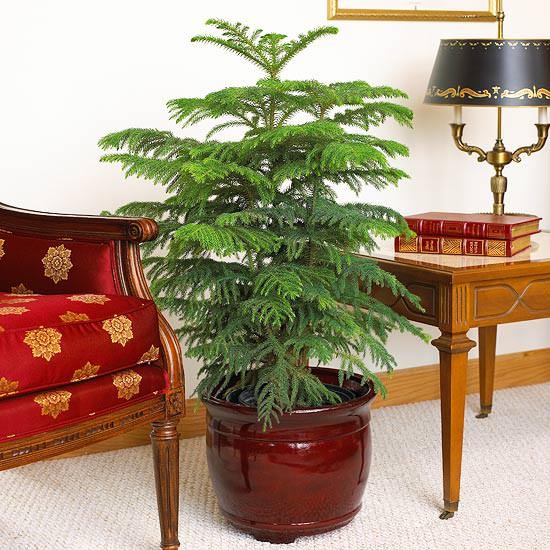
Spider Plant – Who doesn’t love a Spider Plant? Famous for their “babies”, or little plant lets that grow at the ends of stems, and their wonderful arching shape. You can root the “babies” in water easily and create more plants! I love the variegated foliage. Bright to medium light. Keep evenly moist. Leaves will lose color if they are thirsty, but they will bounce right back.
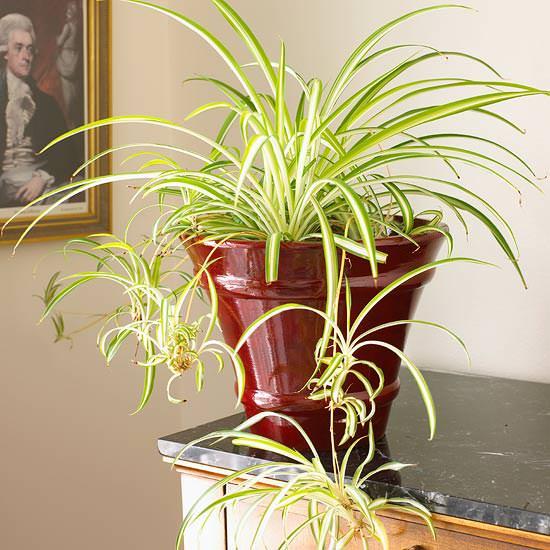
Umbrella Tree (Shefflera) – This larger upright plant has a fan of glossy dark green leaves attached to each stem. Can grow to eight feet tall. Will look leggy in too low of light. Water moderately.

Grape Ivy – Do not confuse this with English Ivy, which can be poisonous. Grape ivy is a wonderful hanging plant, and has glossy bright green leaves shaped like an oak leaf. Will tolerate lower light, but prefers moderate light. Water moderately.
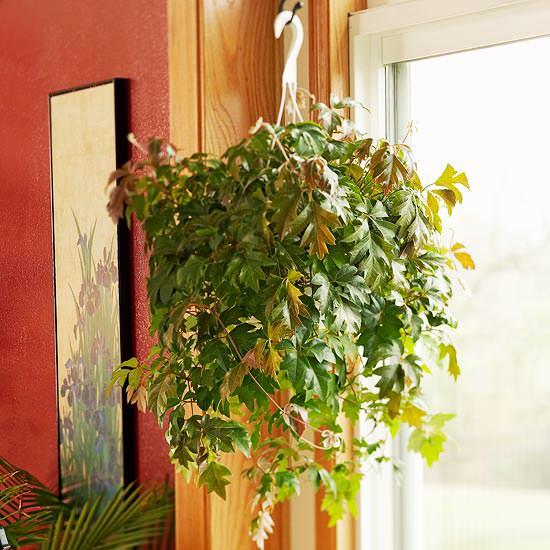
Cast Iron Plant – This plant coms by it’s name honestly…its made like cast iron! Hard to kill… will even bounce back from a bad wilt from lack of water, will tolerate low light and neglect. That having been said, it’s stripy leaves (sometimes spotted with cream) look best in medium light, with evenly moist soil. Thats it! Doesn’t get easier!
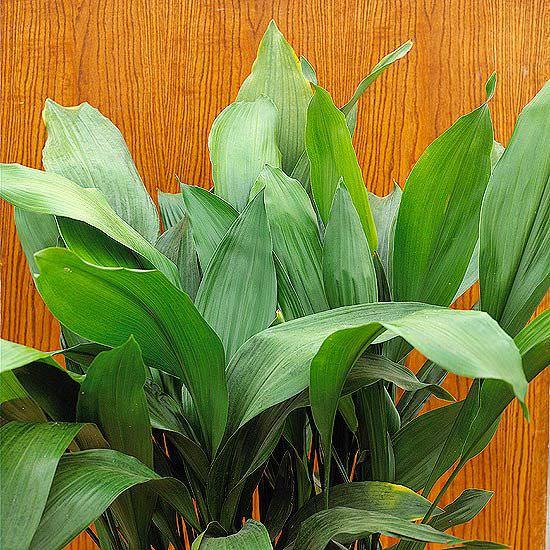
Whether it’s because it’s the depths of winter and you want to see some green living things, or just because you enjoy having houseplants in your home, these easy houseplants are a great place for busy gardeners to start their “indoor garden”.
0
0
文章
Hande Salcan
2017年05月23日

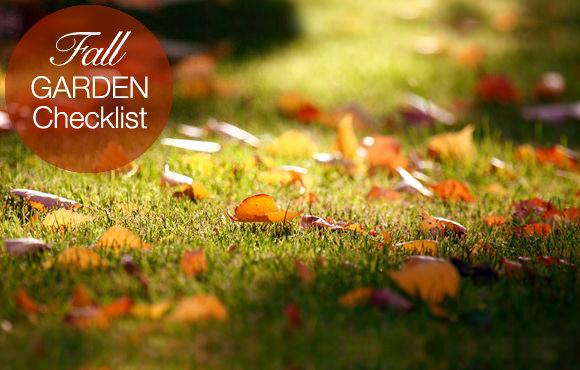
Just because the weather is turning cooler is no reason to turn your back on the garden! In fact, giving your garden a little extra time now can help you have a great gardening season next year. It also happens to be an excellent time to get out and dig in the dirt, get a little exercise, and dream about the changes you are going to make in your garden design. Cooler weather and fewer outdoor activities create the perfect excuse to complete this fall garden checklist!
Amend Your Soil
This is a great time of year to work compost into your soil to improve the texture, drainage or available nutrients. Till in compost from your own yard and kitchen waste, or pick up a couple bags at the store. Do this every fall to have the best garden on the block. This is the number one thing you can do to improve your garden results for next year!
Clean Up!
Yea, you knew I was getting to this… Maybe not the most fun part of fall gardening, but important just the same. Pull out dead or diseased plants and dispose of them. Clean up plant matter at the base of plants and throughout beds. Doing this will make it harder for pests and disease to invade the garden come spring.
Mulch Your Tenders
If you have plants that are borderline in your cold zone, and you would like to try to get them through the winter, make sure you mulch them with a layer of at least 2-3 inches thick. If you mulch trees and evergreens, leave a gap around the base of the trunk to prevent pests from munching.
Order Your Bulbs
If you have always admired those tulips and daffodils in the neighbors yard, well now is the time to set up your own little spring show. Order your bulbs now for best selection online, and plant in late fall before the ground freezes.
Divide Perennials
Now is the time to dig up those overgrown perennials, divide them into smaller plants, and replant. Doing it now instead of spring gives the new plants a chance to put down roots and be ready to go when winter is over.
How to Divide Perennials
Feed the Birds
If you haven’t been feeding the birds all summer, now is a great time to start as their natural food becomes more scarce in autumn.
5 Upcycled Bird Houses, Feeders and Baths!
Feed the Lawn!
If you want that rich green lawn in spring, it needs some attention now. Talk to your local nursery about the right nutrients to apply to your lawn in fall, and get fertilizing one last time!

Sprinkler Care
In late fall, empty all hoses, place faucet protectors, and have your underground systems winterized.

Plant Fall Annuals
Mums, pansies and kale will fill those planters and pots well into fall, so get to planting!
Enjoy!
This is the perfect time of year to enjoy a cup of tea or glass of wine in the garden, and watch the natural world slowly get sleepy. It’s a calming feeling to wait for the coming of winter, because it reminds us there is a season for every thing, and things do change, but that spring will return again!
Here is a wonderful infographic that we came upon and thought we would add to this post – on how to prepare your yard for winter. Check it out. Some good info here.

1
2
文章
lenny
2017年05月23日

Want to know how to make an Urban Vegetable Garden? This article will help you in creating a functional and productive city vegetable garden.

What a pleasure to taste freshly picked vegetables and herbs in soups, stews, salads, in curries and other delicious cuisines, which have been cultivated in your own garden? But what if you live in a city and you don’t have a space for a regular garden?
Well, there are options available even for the city gardeners who have a small home, apartment or a flat. The solution is optimization of the available space you have.
Your little urban vegetable garden will not look like a traditional garden, where rows of tomatoes, beans, onion and cucumbers are planted in line in garden beds and thrive abundantly, but it will bring you immense satisfaction with enough homegrown harvest.
Urban Vegetable Garden Design
First of all, decide how much space you have– do you have a small patio, a balcony or a flat roof? If you have a veranda or a porch, you can use that space too. You can even grow a few plants on a windowsill.
Read our post on windowsill herb garden
Choose the solution of square foot gardening for a city vegetable garden. Square foot gardening is proposed by Mel Bartholomew, it allows to utilize the small space well and increases the productivity.

In a square foot garden, vegetables are grown in raised bed made of individual squares of one square foot each (30 cm) and at least 6″ deep.
Either you can place individual squares side by side to form one large square or make a whole 4’*4′ size raised bed and divide it into 4 squares. Square foot gardening method is a revolutionizing culture, it favors organic gardening. According to Bartholomew, only fertilizer you should use is compost. You can also use manure if it is readily available to you.
In contrast to the traditional garden, which requires a large field to grow vegetable patches and a lot of care, small square foot garden is suitable for limited spaces.
Indeed, this way of growing vegetables greatly helps. Some everyday actions are extremely easy to maintain. You can easily manage crops, it’s so easy to water each plant in a right amount with a simple watering can. No waste, no weed and almost no to less problem of pests. And the icing on the cake are those checkered appetizing and colorful vegetables that look very decorative too in an urban vegetable garden.
You can make such raised beds of wood, PVC pipes and if you don’t mind having permanent structure make a concrete raised bed or you can put individual square containers side by side.
Urban Vegetable Garden on a Balcony
Balconies are even more limited space, but if you receive enough sun there you can easily manage to grow a lot of vegetables and herbs. You can imply the same square foot gardening method or grow plants in containers.
If you want to make a vegetable garden on the balcony, read this post.Rooftop Vegetable Garden
A lot of space in compare to small balconies and if you optimize it well, you’ll be able to cultivate enough vegetables for home use, fresh and organic.
When choosing what to plant in your urban vegetable garden, consider your personal taste first, then of course how compatible your location and space is to grow it. Almost all the species demand ample sun and if your terrace garden is shady, your choices will shrink.
Patio Vegetable Garden

In a city having a patio is a boon. You can make a productive patio vegetable garden there by this square foot gardening method. You can grow vegetables both on grounds and in containers. In addition, grow herbs that you’re fancy about. Almost all the herbs are easy to grow.
You can grow citrus varieties in containers too.
Urban Vegetable Garden on Veranda, Porch or other Enclosed Spaces
Living in a city you know how precious every inch of space is, if you have a porch or veranda, use it to grow vegetables and herbs in containers. Choose plants that are easy to grow in partial shade as most of the time these spaces are roofed and don’t receive full sun. You can try all the green leafy vegetables like spinach, bok choi, and lettuce, root vegetables like carrot, parsnip and potatoes too. Home grown fresh and organic potatoes taste heavenly.
Tips

Don’t cram up the containers or your squares with a lot of plants. Be aware that some vegetables need to be grown alone as they need more space for root development like peppers and chilies. Same in the case with tomatoes, eggplant, and cucumbers. Zucchini also needs to grow alone in a large container.It is best to choose a variety of vegetables that do not send runners and spread as they will fill up the space of containers.By combining vertical supports in squares or containers, you can also grow beans, peas, and small gourds.Carrots, radishes, lettuce, beets are also easy to grow.Fertilize plants regularly with organic fertilizer.
And do not forget that a small urban vegetable garden can be as beautiful as it is functional, especially if you grow flowers in it with vegetables.

What a pleasure to taste freshly picked vegetables and herbs in soups, stews, salads, in curries and other delicious cuisines, which have been cultivated in your own garden? But what if you live in a city and you don’t have a space for a regular garden?
Well, there are options available even for the city gardeners who have a small home, apartment or a flat. The solution is optimization of the available space you have.
Your little urban vegetable garden will not look like a traditional garden, where rows of tomatoes, beans, onion and cucumbers are planted in line in garden beds and thrive abundantly, but it will bring you immense satisfaction with enough homegrown harvest.
Urban Vegetable Garden Design
First of all, decide how much space you have– do you have a small patio, a balcony or a flat roof? If you have a veranda or a porch, you can use that space too. You can even grow a few plants on a windowsill.
Read our post on windowsill herb garden
Choose the solution of square foot gardening for a city vegetable garden. Square foot gardening is proposed by Mel Bartholomew, it allows to utilize the small space well and increases the productivity.

In a square foot garden, vegetables are grown in raised bed made of individual squares of one square foot each (30 cm) and at least 6″ deep.
Either you can place individual squares side by side to form one large square or make a whole 4’*4′ size raised bed and divide it into 4 squares. Square foot gardening method is a revolutionizing culture, it favors organic gardening. According to Bartholomew, only fertilizer you should use is compost. You can also use manure if it is readily available to you.
In contrast to the traditional garden, which requires a large field to grow vegetable patches and a lot of care, small square foot garden is suitable for limited spaces.
Indeed, this way of growing vegetables greatly helps. Some everyday actions are extremely easy to maintain. You can easily manage crops, it’s so easy to water each plant in a right amount with a simple watering can. No waste, no weed and almost no to less problem of pests. And the icing on the cake are those checkered appetizing and colorful vegetables that look very decorative too in an urban vegetable garden.
You can make such raised beds of wood, PVC pipes and if you don’t mind having permanent structure make a concrete raised bed or you can put individual square containers side by side.
Urban Vegetable Garden on a Balcony
Balconies are even more limited space, but if you receive enough sun there you can easily manage to grow a lot of vegetables and herbs. You can imply the same square foot gardening method or grow plants in containers.
If you want to make a vegetable garden on the balcony, read this post.Rooftop Vegetable Garden
A lot of space in compare to small balconies and if you optimize it well, you’ll be able to cultivate enough vegetables for home use, fresh and organic.
When choosing what to plant in your urban vegetable garden, consider your personal taste first, then of course how compatible your location and space is to grow it. Almost all the species demand ample sun and if your terrace garden is shady, your choices will shrink.
Patio Vegetable Garden

In a city having a patio is a boon. You can make a productive patio vegetable garden there by this square foot gardening method. You can grow vegetables both on grounds and in containers. In addition, grow herbs that you’re fancy about. Almost all the herbs are easy to grow.
You can grow citrus varieties in containers too.
Urban Vegetable Garden on Veranda, Porch or other Enclosed Spaces
Living in a city you know how precious every inch of space is, if you have a porch or veranda, use it to grow vegetables and herbs in containers. Choose plants that are easy to grow in partial shade as most of the time these spaces are roofed and don’t receive full sun. You can try all the green leafy vegetables like spinach, bok choi, and lettuce, root vegetables like carrot, parsnip and potatoes too. Home grown fresh and organic potatoes taste heavenly.
Tips

Don’t cram up the containers or your squares with a lot of plants. Be aware that some vegetables need to be grown alone as they need more space for root development like peppers and chilies. Same in the case with tomatoes, eggplant, and cucumbers. Zucchini also needs to grow alone in a large container.It is best to choose a variety of vegetables that do not send runners and spread as they will fill up the space of containers.By combining vertical supports in squares or containers, you can also grow beans, peas, and small gourds.Carrots, radishes, lettuce, beets are also easy to grow.Fertilize plants regularly with organic fertilizer.
And do not forget that a small urban vegetable garden can be as beautiful as it is functional, especially if you grow flowers in it with vegetables.
1
0
文章
Hande Salcan
2017年05月23日

If you are a gardener, chances are you have thought about starting a compost bin. Not only is it great for the planet, but it can help you create “garden gold” and transform your soil into a healthier home for all your plants! Although there are compost bins you can purchase, they tend to be expensive, hard to transport and sometimes downright inefficient. If you don’t know how composting works, take a couple minutes and visit our quick primer on composting techniques, then jump on back here and pick one of these 12 creative DIY compost bins, and get started! Feature photo below, is from ‘A-Z West‘.
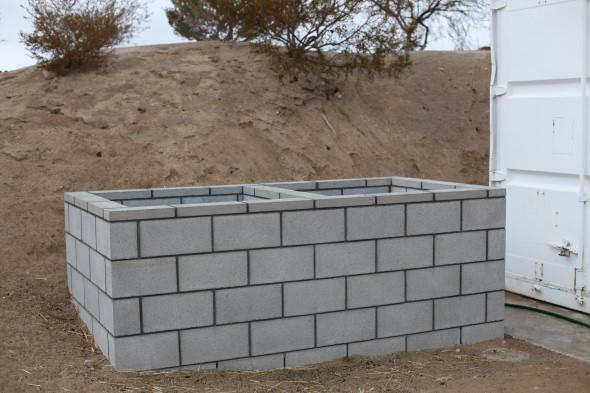
Our first tutorial from ‘Practically Functional’ is a DIY compost bin that has the details… A latching lid, sturdy construction, access to soil at the bottom, and my fav… You can easily open the lid with one hand to dump in the kitchen scraps! Lot’s of step by step directions, photos and drawings.

For those of you who want to use the three bin system and get really serious, this DIY compost bin from ‘Apartment Therapy’ even looks good… Links on how to get the plans for this project are included in their post.

So we love the compact, easy nature of this DIY garbage can compost bin by ‘Full Measure of Happiness’, but unfortunately, that site has gone to the big bloggers resting place in the sky… No worries, keep reading!

Fortunately for all of us, Toni at ‘The Happy Housewife’ has a full tutorial on making a DIY compost bin from a garbage can! Love the pics of her boys “rotating” the bin!

So, maybe you don’t have adorable little boys (or girls!) to push your compost bin around the yard? (Or maybe you do, but they no longer think it’s a cool play-toy. ): ) Using the same idea, this garbage can composter from ‘Instructables’ is on a stand that you rotate the compost bin on. Pretty clever!

If you want to recycle while creating your bin, make this DIY compost bin from pallets from ‘DIY Ready’. Did we mention cheap?

Don’t want to go through a bunch of construction? Make your own compost bin from wire hardware cloth or chicken wire with this tutorial by ‘Mother Earth Living’.

Keep recycling and protecting the earth by making this shower door compost bin from ‘Organic Gardening Magazine’. The shower door acts like a bit of a greenhouse and heats up the compost, making it decompose faster. You can pick one up at a Habitat for Humanity Restore or a similar store near you.

This low cost compost bin from ‘Instructables’ allows you to remove any side, and the whole thing is easily movable as well. Made from inexpensive fence pickets, this is an easy garden project.

From ‘Blue Planet, Green Living’, this DIY compost bin is different in that it’s made using concrete blocks. This makes it easy to make the bin larger or smaller, depending on the needs of that season, keep out critters, or even remove blocks to allow for more ventilation.

Lastly, these compost bins from ‘Birds and Blooms’ are made of cedar, and allow the boards at the bottom to slide out. This lets you remove finished compost from the bottom of the pile, while continuing to add to the top of the pile.
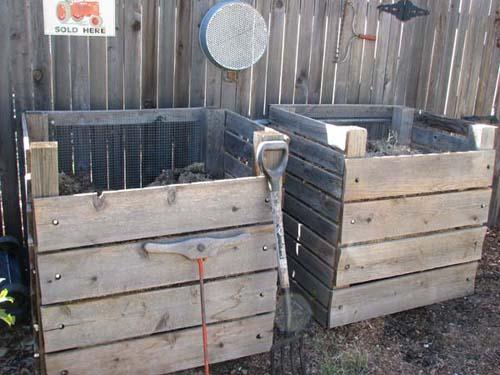

Our first tutorial from ‘Practically Functional’ is a DIY compost bin that has the details… A latching lid, sturdy construction, access to soil at the bottom, and my fav… You can easily open the lid with one hand to dump in the kitchen scraps! Lot’s of step by step directions, photos and drawings.

For those of you who want to use the three bin system and get really serious, this DIY compost bin from ‘Apartment Therapy’ even looks good… Links on how to get the plans for this project are included in their post.

So we love the compact, easy nature of this DIY garbage can compost bin by ‘Full Measure of Happiness’, but unfortunately, that site has gone to the big bloggers resting place in the sky… No worries, keep reading!

Fortunately for all of us, Toni at ‘The Happy Housewife’ has a full tutorial on making a DIY compost bin from a garbage can! Love the pics of her boys “rotating” the bin!

So, maybe you don’t have adorable little boys (or girls!) to push your compost bin around the yard? (Or maybe you do, but they no longer think it’s a cool play-toy. ): ) Using the same idea, this garbage can composter from ‘Instructables’ is on a stand that you rotate the compost bin on. Pretty clever!

If you want to recycle while creating your bin, make this DIY compost bin from pallets from ‘DIY Ready’. Did we mention cheap?

Don’t want to go through a bunch of construction? Make your own compost bin from wire hardware cloth or chicken wire with this tutorial by ‘Mother Earth Living’.

Keep recycling and protecting the earth by making this shower door compost bin from ‘Organic Gardening Magazine’. The shower door acts like a bit of a greenhouse and heats up the compost, making it decompose faster. You can pick one up at a Habitat for Humanity Restore or a similar store near you.

This low cost compost bin from ‘Instructables’ allows you to remove any side, and the whole thing is easily movable as well. Made from inexpensive fence pickets, this is an easy garden project.

From ‘Blue Planet, Green Living’, this DIY compost bin is different in that it’s made using concrete blocks. This makes it easy to make the bin larger or smaller, depending on the needs of that season, keep out critters, or even remove blocks to allow for more ventilation.

Lastly, these compost bins from ‘Birds and Blooms’ are made of cedar, and allow the boards at the bottom to slide out. This lets you remove finished compost from the bottom of the pile, while continuing to add to the top of the pile.

2
2
求助
Tabitha Farmer
2017年05月22日

Can someone help me identify this plant? It had accidently taken root in a combo pot my mother bought at our local greenhouse. I put it in a glass of water and its growing quickly. It reminds me of a succulent in appearance but the fact that it is thriving in water has me questioning if it is a succulent or not and, if so, what kind.


0
0
Tabitha Farmer:Thank you!!
sunnyzou:Portulaca oleracea L. var. granatus
文章
Alicia
2017年05月22日

Learn about the companion plants for tomatoes. Tomato companion plants are those that help it in growing more productively.
The key of getting most productive tomato plants is to plant right companions with it. Read this article to find out which are the best companion plants for tomatoes.

Companion planting is a sustainable way to grow healthy tomatoes without the use of toxic pesticides. Many good companion plant for tomatoes are herbs and flowers like marigold.
Also Read: How to Grow Tomatoes in Hanging Baskets
Tomato Companion Plants: Herbs
Basil and tomatoes in the garden go as well together as they do in the kitchen. Plant two or three basil plants near tomatoes. They not only enhances the flavor of each other and improves growth but also keep the pests away.
Plant garlic between each tomato plant to discourage red spider mites and plant parsley to improve the taste of tomatoes. Chives and mint are pungent herbs that also deter away the pests and are compatible with tomatoes.
Plant borage near tomatoes as it protects tomato plants from tomato hornworm.
Tomato Companion Plants: Vegetables
Tomatoes also do well with beans, peas, peppers, onions and lettuce. Carrots and tomatoes also go well together, although carrots grow little stunned if planted too close to the tomato plants but their flavor will be higher.
Also Read: Carrot Companion Plants
Tomato Companion Plants: Flowers
Flowers planted with tomatoes add variety in the garden. Plant marigolds along with tomatoes – they keep the soil healthy, prevent nematodes and discourage many common garden pests. This bright annual flower also adds color to the garden and attract beneficial insects to your tomato patch.
Calendula also keeps the pests away. As an added bonus, its flowers are edible and added in salads and desserts. Nasturtiums too are good companion plants for tomatoes.
Unsuitable Plants for Tomatoes
While some companion plants improve or do not affect the tomatoes, some plants are best avoided to be planted near them. Generally tomatoes are heavy feeders, they require lots of sun, water and nutrients so you should avoid plants that have higher growing requirements or have pests and diseases like tomatoes. Don’t pare tomatoes with cabbage, broccoli, kohlrabi and other members of brassica genus, as they slow up the growth and development of tomatoes.
Tomatoes and potatoes are also not a good match – both suffer from the same pests and diseases and once it hits one plant, quickly affect the other. Corn is another plant that needs to be avoided as both are vulnerable to a worm that can be transferred between the two plants.
Plants that Do well with Tomatoes
Tomatoes when planted with some plants also help them. A bed of asparagus with a few tomato plants will be more resistant to asparagus beetle. When planted with roses, tomatoes prevent black spot in roses, a fungal disease that attacks the roses.
The key of getting most productive tomato plants is to plant right companions with it. Read this article to find out which are the best companion plants for tomatoes.

Companion planting is a sustainable way to grow healthy tomatoes without the use of toxic pesticides. Many good companion plant for tomatoes are herbs and flowers like marigold.
Also Read: How to Grow Tomatoes in Hanging Baskets
Tomato Companion Plants: Herbs
Basil and tomatoes in the garden go as well together as they do in the kitchen. Plant two or three basil plants near tomatoes. They not only enhances the flavor of each other and improves growth but also keep the pests away.
Plant garlic between each tomato plant to discourage red spider mites and plant parsley to improve the taste of tomatoes. Chives and mint are pungent herbs that also deter away the pests and are compatible with tomatoes.
Plant borage near tomatoes as it protects tomato plants from tomato hornworm.
Tomato Companion Plants: Vegetables
Tomatoes also do well with beans, peas, peppers, onions and lettuce. Carrots and tomatoes also go well together, although carrots grow little stunned if planted too close to the tomato plants but their flavor will be higher.
Also Read: Carrot Companion Plants
Tomato Companion Plants: Flowers
Flowers planted with tomatoes add variety in the garden. Plant marigolds along with tomatoes – they keep the soil healthy, prevent nematodes and discourage many common garden pests. This bright annual flower also adds color to the garden and attract beneficial insects to your tomato patch.
Calendula also keeps the pests away. As an added bonus, its flowers are edible and added in salads and desserts. Nasturtiums too are good companion plants for tomatoes.
Unsuitable Plants for Tomatoes
While some companion plants improve or do not affect the tomatoes, some plants are best avoided to be planted near them. Generally tomatoes are heavy feeders, they require lots of sun, water and nutrients so you should avoid plants that have higher growing requirements or have pests and diseases like tomatoes. Don’t pare tomatoes with cabbage, broccoli, kohlrabi and other members of brassica genus, as they slow up the growth and development of tomatoes.
Tomatoes and potatoes are also not a good match – both suffer from the same pests and diseases and once it hits one plant, quickly affect the other. Corn is another plant that needs to be avoided as both are vulnerable to a worm that can be transferred between the two plants.
Plants that Do well with Tomatoes
Tomatoes when planted with some plants also help them. A bed of asparagus with a few tomato plants will be more resistant to asparagus beetle. When planted with roses, tomatoes prevent black spot in roses, a fungal disease that attacks the roses.
3
3
文章
Alicia
2017年05月22日

Learn about the companion plants for carrots. Carrot companion planting plays a helpful role in the growth of carrots.
If planted together, carrot companion plants help in improving taste, attracting beneficial insects (pollinators) or repelling pests away. In addition, the use of such plants in combination allows a rational use of space in the garden and decrease the use of pesticides.

Carrot Companion Planting
Here are some plants that are advantageous to grow together (on adjacent rows or alternately in the same) with carrots to stimulate its growth: You can grow beans, peas and other legumes with carrots. Salad greens, bokchoi, lettuce or the plants that belong to cabbage family are good companion plants for carrots.
Sowing radish seeds together with carrot seeds is good for carrot’s growth. Radishes germinate quickly and help in germination of carrots. Also, they are harvested earlier than carrots and when rooted out, they make room for carrots to grow.
Tomatoes can be planted with carrots. Chives, onion, leek and garlic are good companion plants too, they also keep the pests like carrot flies away.
In herbs, you can grow sage, parsley and rosemary with carrots.
Foes
If planted together, carrot companion plants help in improving taste, attracting beneficial insects (pollinators) or repelling pests away. In addition, the use of such plants in combination allows a rational use of space in the garden and decrease the use of pesticides.

Carrot Companion Planting
Here are some plants that are advantageous to grow together (on adjacent rows or alternately in the same) with carrots to stimulate its growth: You can grow beans, peas and other legumes with carrots. Salad greens, bokchoi, lettuce or the plants that belong to cabbage family are good companion plants for carrots.
Sowing radish seeds together with carrot seeds is good for carrot’s growth. Radishes germinate quickly and help in germination of carrots. Also, they are harvested earlier than carrots and when rooted out, they make room for carrots to grow.
Tomatoes can be planted with carrots. Chives, onion, leek and garlic are good companion plants too, they also keep the pests like carrot flies away.
In herbs, you can grow sage, parsley and rosemary with carrots.
Foes
0
0
文章
lenny
2017年05月22日


I’m a big fan of herbs… I love how they smell, the texture they provide, that self sustaining feeling they give you, just having them in the garden. But I’m also a big fan because I’m convinced many of them can do you good and help you heal from minor ailments. I chose eight of my top fav healing herbs for the garden based on how easy they are to use and prepare at home, and also how easy they are to grow in most gardens. Here they are, in no particular order! (Note: Remember that healing herbs are not meant to be medicinal, and that you must be careful that any plant you ingest is safe for you and your family… )

1. Chamomile
Chamomile is known by almost everyone for it’s ability to ease us into sleep, when steeped into a tea. It also is used for stomach upset. Dry the flowers for long term storage in ziploc bags, or use them fresh steeped into a tea. This is a gentle herb that can be used for children as well.
The best variety to grow, and the most commonly used for tea is German Chamomile. This is an annual that grows into a bushy plant about 2 feet tall. It prefers well draining soil, full sun to part shade, and moderate water. Chamomile is easy to grow from seed.

2. Feverfew
Feverfew (Tanacetum) has had some scientific studies done on it’s use for migraine headaches, with some positive results. Brewed into a tea, feverfew is best used as a preventative for migraines.
Grow Feverfew from seed, sprinkled onto the soil in early spring. Like Chamomile, it needs light to germinate, so don’t cover, just water in. Give it plenty of sun and you will be rewarded with hundreds of tiny button daisy flowers on a 20 inch bush. This is also an annual, but tends to self seed liberally. Also like Chamomile, brew flowers into a tea.

3. Lavender
Lavender is used to ease tension, and is generally used in aromatherapy… that is, the scent is used in oils and infusions. It is also edible, the flowers being used in salads or drinks, and can also be brewed into any tea.
Easy to grow, lavender loves the sun, and is drought resistant. It does fine in poor soil, but the soil must be well drained. It will not tolerate heavy soil. Several different types and colors are available , the most common is English Lavender, but French Lavender and Spanish Lavender are popular as well, although less hardy. The varieties bloom at slightly different times, but usually from later spring through mid summer, with another short flush in the fall. A short lived perennial, it will come back for several years, but will then tend to die back, stating in the center of the plant. Luckily, you will find many volunteers popping up ready to take it’s place. Did we mention, it’s gorgeous as well?


4. Peppermint
Peppermint is one of the tummy trouble remedies I actually use, and so do my kids… It really does help relieve nausea and even stomach cramps. It can be energizing as well.
Peppermint is an aggressive plant that can take over a garden if you let it! Although I love growing any kind of mint, if you don’t want to be pulling it like a weed, plant it in pots. Prefers afternoon shade in hot areas, can tolerate some shade in any area. Perennial that comes back every year. Grows best in fertile, moist soil. Flowers are not showy. Foliage is aromatic, and leaves are edible in salads, sauces and can even be frozen in ice cubes to refresh cold drinks.

5. Thyme (Thymol)
Thyme is a powerful antiseptic and astringent. Used for coughs and sore throats, it is gargled with or made into a tea, usually in combination with other herbs. Also used as a disinfectant spray.
Thyme is an herb that has become popular with several decorative varieties in the last few years, including one of my favorites, ‘Doone Valley Thyme’ with its pink flowers. Flowers are tiny but plentiful, and the plant loves sun and tolerates drought. Varieties exist from the low growing ‘creeping Thyme’, to the parent variety, common thyme. Common thyme has been said to have the highest level of Thymol, or oils. A semi woody shrub, it is useful in the garden as well as the kitchen. Easy plant to grow.

6. Garlic
Garlic is one of those herbs that continues to prove it’s health benefits. Long known for it’s cardiovascular health benefits, it is also used as an anti viral and anti fungal… In my opinion, the best way to take advantage of the healing powers of garlic is to cook with it!
Garlic is easy to grow, especially if you already grow vegetables. Each clove from a garlic bulb will grow into it’s own bulb, and yes, you can plant from grocery store garlic. Simply soak them in a jar of water with a tablespoon of baking soda before planting, to prevent fungal diseases.
Plant garlic in fall, and allow to overwinter. In June or July, when the green stalks are 3/4 brown, gently dig up bulbs and tie together several bunches, then hang to dry. Store in a dry, cool place.
Make really good pasta!

7. Lemon Balm
Lemon Balm is used in a tea for anxiety. Just pick the leaves as desired and brew.
Grow lemon balm in partly shady area for best results. Rich, moist soil will give you the best plants with the highest amount of oils in the leaves. Being a tender perennial, it will not survive any but the modest winters.

8. Parsley
Lastly, we have parsley. More than a garnish at the side of the plate, parsley helps cleanse the liver, flush the system of excess water and soothes the stomach.
Parsley prefers part shade and rich soil, and does well grown indoors in a sunny windowsill. I prefer to grow the flat leaved variety. Give afternoon shade in hot areas. Harvest by cuttings leaves as needed.

‘Country Living’ shows you how to make herbal tea from your garden plants…
Easy list of eight healing herbs you can grow in your garden! Anyone have a favorite we missed? How do you grow and use it?
1
0
文章
Abigal
2017年05月22日


Our backyards are used for BBQ’s and family gatherings, playgrounds and football games. Don’t forget to use your yard for some good ‘ol wind down time! These 13 projects for backyard relaxation will help turn your garden space into a zen place. Catchy, right? :) Our feature project above, is a hanging bed from ‘The Devoted Wife‘.
From ‘Pottery Barn‘, we love this backyard bed space too! Want to make one of your own? Then jump on over to our post on DIY garden hanging beds and find a bunch of great tutorials!

If you love those hanging beds, then try something a little different with this deck makeover by Sarah Dorsey for ‘Home Depot’. In this one post, there is a tutorial for her DIY hanging bench, cable railing, privacy curtains and deck makeover. What a cool space to have a glass of wine or tea in!

Need a more comfy spot, perhaps under a tree? For a whole afternoon? We feel ya. Try this DIY hammock from ‘Martha’ made from a simple drop cloth.

Or learn how to make a rope hammock from ‘Kinfolk’. This is just inexpensive nylon rope and overhand knots! Or for more ideas, check out our post on DIY hammocks.

Amy of ‘Her Tool Belt’ did this DIY chaise tutorial from 2×4’s for ‘Bob Vila’. Just in case you were getting tired of laying down… ;)

These DIY chaise lounges look perfect for a warm afternoon! Made by ‘Being Brooke’ at ‘Ana White’, she did these for $35!

Ok, now you have a place to relax your body, now it’s time to relax the soul! Start with water… this DIY fountain from ‘Oregon Live’ ought to do it!

‘Diane and Dean’ have another take for you…. They did this garden fountain on the edge of an existing pool to add to the ambience, and it looks kinda “tropical wonderland” to us!

If water hasn’t gotten you there, how about wind? Make your own wind chimes with this tutorial by ‘HGTV’. This is a simple project using a craft round, pipe and twine.

Or make these DIY wind chimes in an hour with things from the shop, including simple washers! From ‘Bob Vila’.

Ok, so now you’ve had a relaxing afternoon, but the evening is creeping in… No need to start the stress parade again.! Just fire up your DIY propane fire pit! This one from ‘WC Welding’ was done in just 5 steps from a garden patio table.
Finally, if you want to get a bit serious, jump on over to one of our fav sites, ‘Homemade Modern’ and learn how to make their concrete fire pit.

Ok, are we officially in kick back mode yet?
0
1
文章
Abigal
2017年05月21日


It’s pretty tough to enjoy summer activities in a backyard that bakes in the afternoon heat. We all need a way to get out of the sun, but still be able to spend time outdoors. We found these 9 clever DIY ways to a shady backyard oasis for you to help turn your space into a retreat! We didn’t want to just share the same ol’ wood pergolas (though if thats what you are looking for, check out our post on DIY pergolas!) so we hope these unique and creative shade structure ideas hit the shady spot!
Our feature project above, is a DIY drop cloth fabric shade cover made by ‘Anything Pretty’. Check out her tutorial, it took them just a couple of hours to get this up, and made over their old pergola! LOVE the globe lights woven through the shades.
Here is another tutorial for a fabric shade by ‘Koiphen’. Good close up photos here to help you understand the wire system for holding the shades.

From ‘J and B Marvin’, this DIY fabric pergola has a quick tutorial, and a lot of good tips. Same type of system as the project above. This is fully retractable too!
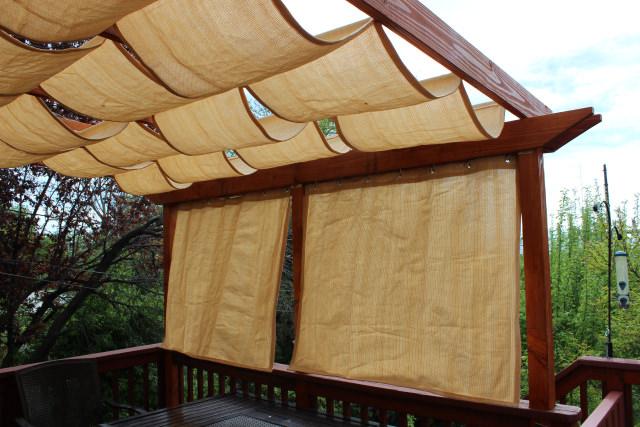
Ok, so you need Google Translate for this one, unless you read Dutch. At least, I think it’s Dutch! But I love this one, because it’s a freestanding DIY fabric pergola that can be put up even where there is no existing structure. From ‘VT Wonen’.

Hope you were paying attention to those tutorials, ’cause these next few ideas don’t have instructions, but they follow the same principles of the ones you’ve seen so far! This space from ‘InDecora‘ has a simple wire mounted fabric shade, with grommets to string the cable through. Grommet kits can be bought at craft and sewing stores, and this could be made out of sturdy canvas drop cloths from the hardware store.
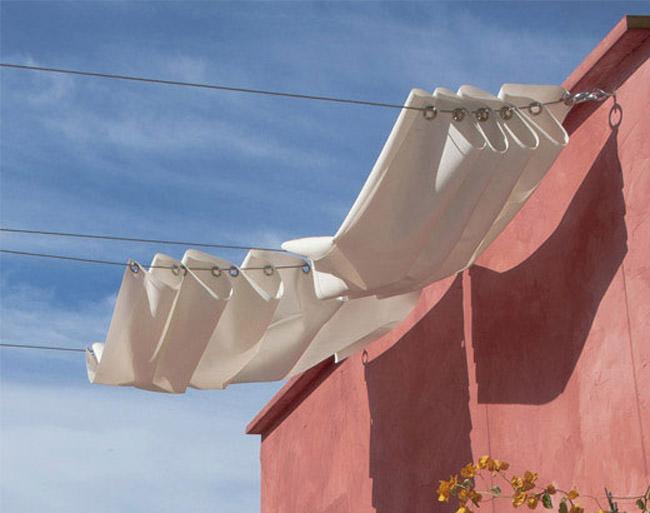

Same idea as some of the projects above with this slide wire canopy from ‘Superior Awning’.

From Jamie Durie of ‘HGTV‘, these sliding canvas panels are mounted and slide the same way as the fabric ones above. There are eye hooks mounted on the frame of the panels, and the wire cable slides through the hooks, over the top of the panel. These can be moved to cover different areas of the space as the sun moves.

Also from ‘HGTV‘, covering sections of your existing pergola with canvas cloth makes a more permanent shade structure. Clever!

Finally, if you want a cool look for over your patio, or even your pool, think about using shade sails. They come in triangular and rectangular shapes of different sizes, and are attached to posts, trees or buildings with hooks and cables. Check out our post on how to hang shade sails for more info on this project!
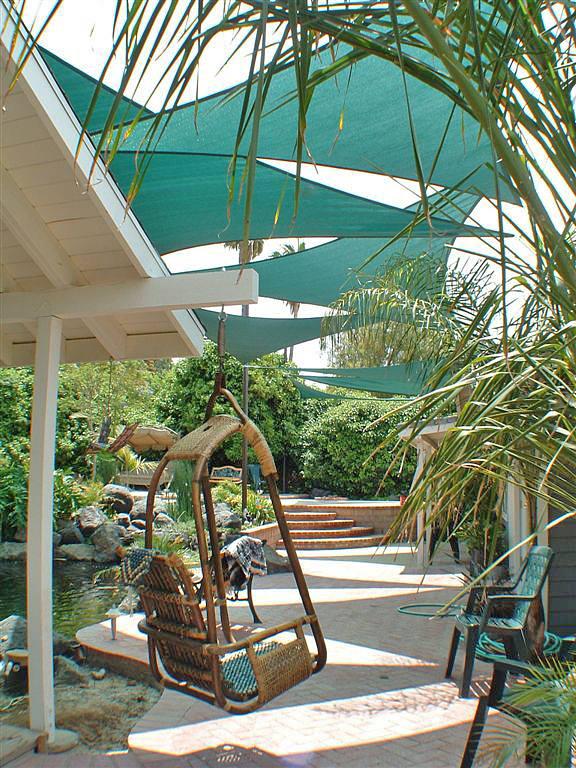
0
0




